#alba goes to italy
Explore tagged Tumblr posts
Photo
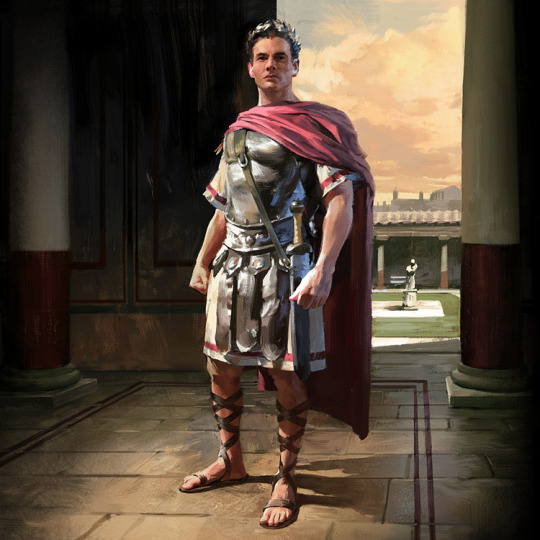
The Legend of Romulus
Despite allegedly founding Rome and being hailed a hero, Romulus’ legacy is complex and his biography is even disturbing at times. He was supposedly guilty of committing many terrible deeds that still make readers recoil, but according to legend, his transgressions often led to positive outcomes – at least from the Romans’ point of view. Thanks to his efforts' results, the Romans largely celebrated their fabled founder, and it seems that they recognized valuable lessons hiding within his biography: greatness sometimes stems from disgrace, and the path to redemption is often close at hand.
Lineage & Birth
According to Rome's canonical foundation myth, Romulus was born sometime in the 700s BCE. His parents were supposedly a priestess – called Rhea Silvia – and the god of war Mars, which provided Romulus with a pedigree second to few in the ancient world. To some, this might have intimated that he would enjoy a lifetime of opulence, without serious challenges, and he would be a paragon of morality. On the contrary, Romulus was fated for a life marked by instances of ignominy and egregious misdeeds.
Romulus’ maternal grandfather was known as Numitor, and he was king of Alba Longa, which was an influential settlement nestled in the Alban Hills of central Italy. Ancient historians traced its foundation to none other than one of Aeneas’ descendants. However, sometime after Numitor ascended to the throne, his jealous brother Amulius conspired to overthrow Numitor’s rule, and somehow, he succeeded in his endeavors and became Alba Longa’s king. In order to further secure his grasp on power, Amulius treacherously ordered the murder of Numitor’s son, Aegestus, and forced Numitor’s daughter, Rhea Silvia, to become a priestess to Vesta who was the goddess of the hearth. Since such priestesses were required to be chaste during their tenure under the pain of death, Amulius assumed that Rhea would not mother any potential rivals to the throne. But as the Romulus tale goes, Mars ravaged her one day. This led to her pregnancy, and she later gave birth to twins: Romulus and Remus.
Even though Rhea attempted to conceal the truth, Amulius learned of Rhea’s pregnancy, and shortly after Romulus and Remus’ births, the rogue, tyrannical king of Alba Longa condemned the infants to death by drowning. Yet by a dispensation of fate, they survived. Initially, a wolf named Lupa allegedly protected them until a shepherd called Faustulus rescued the boys and raised them as his own children. Around 18 years or so after their abandonment, Romulus and Remus returned to Alba Longa, led an armed revolt, and freed the Alba Longans from the despot's control, killing Amulius and placing the gentle Numitor back on the throne.
Author Promotion
Continue reading...
40 notes
·
View notes
Text
professional help, c2. 'The urgency.'
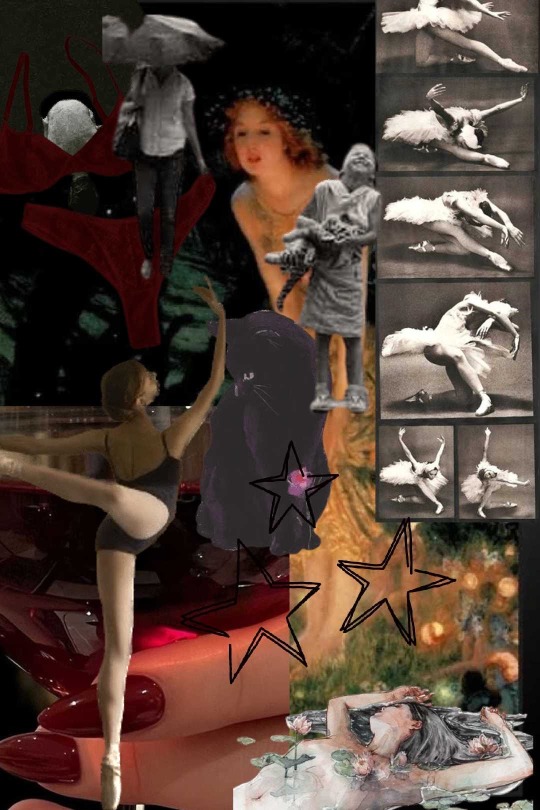
simon riley x original character.
trigger warnings: violence, sexual assault, mentions of rape, trauma, sexual themes, swearing, use of alcohol and drugs, eating disorders, depression.
song to listen to when reading this: The Chain, Fleetwood Mac.
abstract: this is Jude, this is a little bit of information about me since you care so much, I don't even know you… anyway yes, I really like being mysterious, what you gonna do about it, punch me in the face? I'm not even real, grow the fuck up. see ya.
Sometimes, she just fucking hated her life. She supposed it was normal like that, it happened to everyone to absolutely fucking despise their lives, no? She wakes at the same hour everyday, does her makeup. Not too much, not too little to show she was sleep deprived and got high last night. Her identity was concealed under eyeliner and blush. She looks like a doll. She likes her makeup, she's quite good at it. She plays with her hairstyles, sometimes a bun, sometimes braids, sometimes loose with a headband, depending on the mood. She walks her dog and cleans his poop. Jinx, a 5 month old Belgian Malinois she adopted when she moved. She found him at a shelter for abused puppies, he was the last one to get adopted. She decided to take him, she planned to move to the countryside soon anyways. Gaining his trust was one of her biggest accomplishments, now the dog had a bit of an attachment issue, but they were working on getting better together. She drives to work with the same 4 playlists playing in her car. Old rock, Frank Ocean, some Italian songs here and there.
She always comes in dressed in dark colours, dark red, dark blue or black. She has 10 male patients and 8 female soldiers. Some of them are combat medics, some snipers. Demolition experts. She works 'till lunch time, eats alone, sometimes skips lunch just to make her body feel something and indulge in disordered eating, then goes outside to smoke and comes back in. After the afternoon sessions, she sometimes has groups together for some group therapy. Then she usually goes home and smokes weed while she cooks her dinner, she acts like she's in MasterChef, puts on music and pours herself a glass of wine 'Quando sei qui con me' she sings to her dog, 'Questa stanza non ha più pareti, ma alberi'. Jinx doesn't even know Italian. Two times a week, she teaches ballet at a local dance school. 13 year old is not old enough to be on point shoes. It's her favourite time of the week though. She gets to finally have control of a situation, she gets some respect. 13 year olds, a fucking nightmare… She gets to tell them what to do and correct their arms, their feet, their posture and they listen! They do, and they like her, they say thank you Alba, see you next week! They learn her choreographies, they follow her lead when she explains a new variation. They even like the songs she chooses for warm up. Mostly Abba.
Alba is not her real name, but they don't know that. A gift from Laswell, when she started working for her. A sparkly new identity, English ID and nice documents that prove she's an English citizen, born in Southampton. She's not. Kept a little bit of Italian in the fake name. She hasn't been in Italy in close to five years. She went on vacation alone in Tuscany once, just to feel her country again for a second. She is not in contact with her family, last message from her sister was three years ago, it went 'I hope you're alive.' Her mother taught her violence. To be in power. To be beautiful and kind. To never ever trust someone who wouldn't give their life for you. Her mother taught her loyalty, respect. She used to never cry as a child. She loved to know stuff, to read about planets. She would kill lizards in the backyard with her little brother, who died young. She saw her first gun at 13. Now, her name is not Alba and it sure isn't Jude. Or Judy, as some patients call her. They know it's a callsign, a code name, everyone has one, especially in the task forces. Hers is Jude. 'Jude looks like an angel, but her words have thorns'. That's what Billy Lunette had to say about her. Billy had been her favourite patient for the whole of 2021. He had PTSD, he had night terrors and was in a mental hospital for schizophrenia symptoms for a while. He wouldn't take his medication, he would smoke, he was a mess. He listened to her though. She was the only one who visited him in the hospital. She showed him he could trust her and he completely lost himself in her. He would call her at 3 in the morning, drop by her office too many times per day, developed a bit of a codependency, but she was able to help him through his pain. He would do research about the treatments, the medicine, cognitive behavioural therapy. Billy was happy now. He was grateful to have had her and she was grateful that Billy had been a great patient. Big challenge. Billy was her biggest accomplishment, and proof of the fact she wasn't completely useless in the army.
She didn't work for the entirety of 2022. She had an accident with one of the patients, classified information. She survived, but man was it hard to live after that day... Spent time with her dog, visited a friend in San Francisco, taught ballet. Price and Laswell felt so guilty they continued to pay her even if she wasn't working. Why she decided to come back she really didn't know. She thinks the truth is she likes helping people, makes her feel good. She likes the crazy stories and that she had a reputation at the base, she was starting to be respected. She craved that. And it really started to bore her, the routine. Until Arash. Seeing Arash so frighted and tense was new, he was a calm and polite gentlemen. She saw an invisible string tying his story and his damned pilgrimage book to the mission she knew had failed in the Middle East. Now, it was a little bit of a stretch. So she did her little research, put her Sherlock hat on, lit a cigarette and started digging.
She had fun, until things really started clocking. He was missing his doctor appointments on purpose on specific dates, to go do what? Call someone? She couldn't steal his phone. Send letters? She tried the post office but found out nothing. The bank really did give her his statements, which was pure luck. He had set his personal security questions as his birthday and his mother's name, which she knew, because he told her. She knew everything about him, even his social security number. Arash really trusted her and she had an incredible memory for unnecessary details. Also, he left his wallet on the couch in her office countless times, it’s not that she looked, it was just there and she remembered. When she saw him stressed and fidgety she knew he was hiding something. She kept a straight face, 'Arash, we can really talk about whatever you want, you know' and he would interrupt her 'You don't understand. The urgency!', he continued to say. She really didn't want to tell Price herself, she would have preferred for Laswell to do it. She took extra time in the morning to get ready that day. She was going in a separate area she knew very little about, and nobody knew who she was. Sometimes people mistook her for someone's wife, or daughter. She chose her outfit accordingly, she wanted to seem professional. She wore a sports bra. There was nothing to look at anyways. She didn't put on lipstick, not even the nude one. She was used to being underestimated, and being looked down at. She was also used to raising her voice and presenting herself as stoic and cold. She knew perfectly how to be violence. She noticed a familiar face once she opened the door of the briefing room. A familiar face mask. The skull guy, she had seen him before. Was he the guy…
She could't get distracted. Her little mission went smoothly. She always knew Price liked her and feared her at the same time, and when it came to his little soldier boys, she really didn't care what they thought. The guy from the day of her accident even spoke to her. Poor thing. She was really amused no one told him about the reason why she didn't want to go home alone. He did really good that night, she remembers him well. He didn't try to speak too much, he sounded gentle. A gentle giant. Unfortunately for him, no one was gonna tell him about that day. When she left the room, she went straight home. She doubted someone would ever contact her again about the situation, they would handle it themselves, and probably very badly. She was driving to her ballet lesson, still thinking they all looked so confused by her words. They were probably gonna do a stupid interrogation, or rather do nothing and wait for the next mission to be a shit show. Imbecilli.
'Alright girls, one more time please!' At least she had her little ballerinas to cheer her up. She had them warm up, she usually did the warm up routine with them. She walked between the four rows of kids at the barre, delivering her corrections. Jennifer usually had stiff hands, and she was tense in her shoulders. Kyla had a beautiful turnout but she often confused her arms positions. The jetes routine, they always forgot that one. 'It's three in front and switch… guys I'm not gonna repeat myself'. She thought she sounded rude sometimes, but 13 year old American girls were a nightmare to work with. Last month, she even had to deal with poor Gemma being bullied in the changing rooms. 'I'm gonna say this just once, three in the front, switch to the back.' she liked demonstrating, felt like she was taking lessons herself. 'Ta-ra, ta-ra, ta-da. And we're gonna hold here' she lifted herself on her toes and attached her right pointed foot to her knee. She let go of the barre, holding her balance on one foot. 'Passè.' she said. The girls groaned. 'The more you complain the more I'm gonna make you stay like this girls. We're gonna do one minute.' She went to the side of the room, to play the music 'From the top.'
notes: translation of the song: 'Quando sei qui con me' when you're with me, 'Questa stanza non ha più pareti, ma alberi', this room doesn't have walls no more, it has trees.
notes: Alba means something specific!
translation: imbecilli, means imbeciles.
notes: let me know what you think !! <3
love, mare.
taglist:
@ummmmmwat @ghostlythots @sweetfemmefatal @natxpat @chavarriakeren647 @ravenmoore14 @farther-than-pleiades @internallyscreamings @hwromi @atoxicrat @cuti3maddi3 @deafeningkittenblaze @its-celeste @serene-hills @lexidoll12 @poohkie90 @lunatiquess
@warmedbythebody @katzykat @iristhemuse @azkza @keiraslayz @abbyandermine @jennyjencakes @dest-nai @corset-briefs @nutze-kekse @ilytsukiw @b3anspr0ut
@pondsblog @missyouzoe @fallenkitten @bigauthorrascalturkey @bethtay @angelynn-nicole @starluv @stargirlisworld @giyuuslittleslut @impossiblecupcakelight
@rkrivees-blog @ghosts-hoe @kam1snotverysmart @gauky76 @freyjaaasstuff @spicyspicyliving @scottpilgrimvsmyfists @courtney0-0 @shinchanboi @darling006
#cod mw2#cod x reader#ghost cod#simon ghost riley#ghost fanfiction#ghost headcanons#simon ghost x reader#call of duty#cod fic#cod modern warfare#141 headcanons#141 x reader#cod 141#task force 141#tf 141#mw2 141#cod#cod headcanons#gaz cod#john soap mactavish#john price#captain john price#captain price#cod ghost#cod mwii#call of duty modern warfare#call of duty x reader#mw2 x reader#cod fanfic#call of duty fanfic
53 notes
·
View notes
Text


By Jane von Mehren
11 January 2023
The highly civilized Etruscans had a huge impact on the city’s eventual geography, architecture, government, trade, and agriculture.
They created excellent schools to which rich Romans sent their sons, much as they would later send them to Greek institutes.
By the sixth century B.C., some of Rome’s most famous institutions, from the Forum to the Senate, were in existence but even the most reputable historians — including Fabius, Livy, and Plutarch — started their accounts of the empire in legend.
Legendary beginnings

The story of Rome’s founding begins in Alba Longa, the first “city” of Latium, a region in central western Italy, occupied by Latins.
The area had been inhabited since the Bronze Age by farming communities and was known to the ancient Greeks, which is perhaps why Aeneas, a Trojan prince, is said to have established it around 1150 B.C.
According to legend, in Alba Longa, two of Aeneas’s descendants, the brothers Amulius and Numitor, fought over who would rule.
Amulius triumphed, killing Numitor’s sons and exiling his daughter, Rhea Silvia, to become a Vestal Virgin.
Through divine intervention, she gave birth to the twins Romulus and Remus.
Threatened by these potential claimants to his throne, Amulius beheaded Rhea Silvia and abandoned the babies in the river Tiber.
Miraculously, a she-wolf rescued and cared for the boys until a shepherd, Faustulus, adopted them, raising them on the Palatine Hill, located in modern-day Rome.
The legend goes on to say that the brothers established the city of Rome on the banks of the Tiber River, where it was narrow enough for crossing and the hills provided a good defensive position.
The land between the hills, however, was quite marshy and not all that fertile.
The twins soon quarreled about the city’s exact boundaries and Romulus killed Remus.
Romulus, along with the outlaws and criminals he recruited, invited neighboring tribe the Sabines, who had resisted intermarrying with the Romans, to a fête.
During the merriment, Romulus raised his cloak signaling his men to seize and abduct the young Sabine women.
As the origin story goes, being Roman wives suited the women and they stopped the Sabine men from battling the Romans when they came to recapture them.
In the end the Sabines remained in Rome as part of the new city.
Influences in the area

Archaeological evidence tells us that Rome’s actual origins were less dramatic.
The first Romans were Latin farmers and shepherds living in small village huts on the Esquiline and Palatine hills.
The Sabines, a tribe living to the north, divided soon after the city’s founding, and some of them came south and united with Rome’s people.
Rome remained relatively primitive until the 600s B.C., when the Etruscans, who controlled a series of city-states to the north, began taking control of the city.
Kingdom of Rome

While modern scholars discount some of the accounts of ancient Roman historians, they agree that during the first phase of its history — from approximately 753 to 509 B.C. — Rome was ruled by kings.
According to these writers, Romulus was the first, succeeded by Numa Pompilius, a Sabine, and in 616 B.C., by an Etruscan named L. Tarquinius Priscus.
Kings had almost absolute power, serving as administrative, judicial, military, and religious leaders. A senate acted as an advisory council.
The king chose its members, who became known as patricians, from the city’s leading families.
Unlike later monarchs, Roman kingship was not inherited.
After a king died, there was a period known as an interregnum, when the Senate chose a new ruler, who was then elected by the people of Rome.
The king-elect needed to obtain approval of the gods and the imperium, the power to command, before assuming his throne.
Etruscan influences
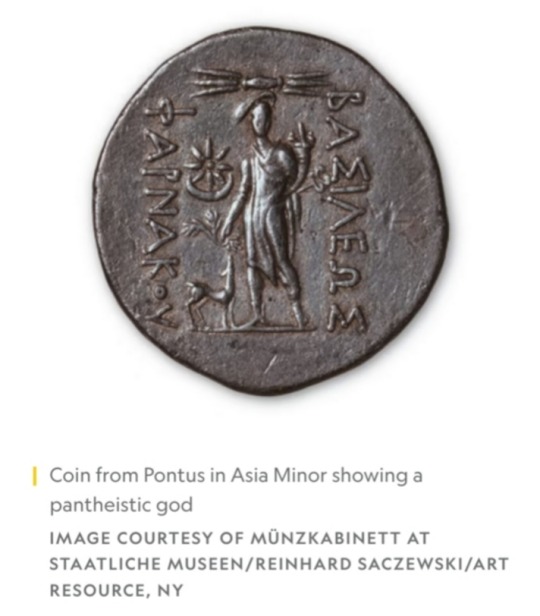
The Etruscans ruled a loose confederation of city- states that stretched from Bologna to the Bay of Naples.
It remains unclear where they originated, but they used a version of the Greek alphabet and some ancient sources describe them as coming from Asia Minor.
Around 650 B.C., they were already dominant in the region and took control of Rome, wanting its strategic position on the Tiber.
Under Etruscan kings, Rome grew from a series of villages into a proper city.
The Etruscans drained the marshes around the city, constructed underground sewers, laid out roads and bridges.
They established the cattle market, Forum Boarium, as well as Forum Romanum, the central market and meeting place that evolved into the heart of the empire.
Toward the end of this period of Etruscan influence, the first temple of Jupiter was built on the Capitoline Hill.
This temple, although rebuilt many times, became the symbol of Rome’s power.
Founding the Republic

The era of Roman kings ended in 509 B.C., when the Romans supposedly expelled the last Etruscan king, L. Tarquinius Superbus, in another mythicized event.
As recounted by historians, including Livy, the son of Tarquinius Superbus, Sextus, raped at knifepoint the noblewoman Lucretia, wife of the king’s great nephew.
Lucretia, feeling that her honor and virtue had been lost, committed suicide.
Her uncle Brutus swears to avenge her and commits to revolution and the expulsion of the monarchy.
To the Roman people, her story represents the tyrannical powers of the monarch on the state, and so the saga of Lucretia is cited as the event that spurred the Roman Republic into being.
In place of the monarchy, Romans established a republic, which lasted until 30 B.C.
Over the course of nearly five centuries, Rome became a dominant Western power, seizing territory throughout the Mediterranean, creating an enormous and efficient army, and learning how to administer its vast provinces.
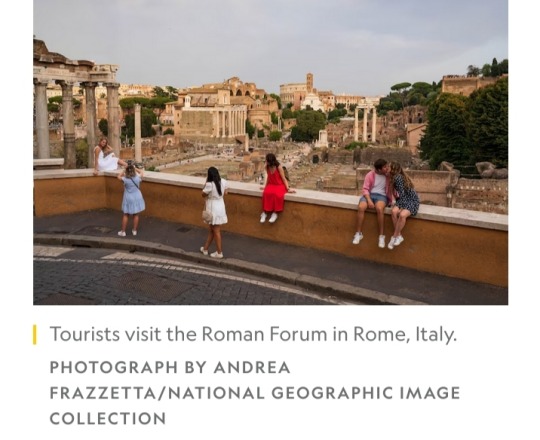
NOTE:
The traditional date for the founding of Rome is 21 April 753 BC.
#Rome#Ancient Rome#Romulus#Remus#Alba Longa#Latium#Italy#Aeneas#Amulius#Numitor#Rhea Silvia#Vestal Virgin#Faustulus#Palatine Hill#Tiber River#Sabines#Etruscans#Numa Pompilius#L. Tarquinius Priscus#interregnum#imperium#Forum Boarium#Forum Romanum#Capitoline Hill#Temple of Jupiter#L. Tarquinius Superbus
8 notes
·
View notes
Text
Mythic Creatures by Culture & Region
Part 3: Europe (Basque, Rome, Viking, Great Britain)
This list documents mythological and folkloric creatures of Ancient Europe, the British Isles and Scandinavia as found on Wikipedia.
European creatures from Eastern Europe, France, Germany, Italy, Greece etc. will be listed in a separate post. The same goes for Biblical creatures or creatures from Abrahamic religions and Goetia literature. The full list of creatures is here.
Basque
Basque people live in what is today northern Spain. Their language is the only surviving language in Europe that isn't part of the Indo-European family tree, likely because the Basques live in secluded mountain areas. I have listed some deities alongside creatures, but this is a full list of Wikipedia's Basque creatures, not a full list of Wikipedia's gods/goddesses/deities for Basque culture.
Aatxe; Aide air goddess; Akerbeltz; Amalur; Basajaun; Eate (Basque god); Egoi; Eki (Basque goddess); Fountain Women; Gaizkiñ; Gaueko; Herensuge; Ilargi; Inguma; Iratxo ; Iratxoak; Jentil; Lamignak; Mairu; Minairó also Catalan; Odei; Olentzero; Orko; San Martin Txiki; Tartalo
Proto-Indo-European
Proto-Indo-European (or PIE) is the reconstructed ancestor to all major European languages, excluding Basque and languages from later diasporas.
Dʰéǵʰōm; Proto-Indo-European Myth; Double-headed eagle maybe not PIE but Bronze Age
Roman
Abarimon (Pliny the Elder, whose source is supposedly a land surveyor of Alexander the Great); Aborigines_Roman myth\; Achlis (Pliny the Elder); Caligo, see Achlys; Aegipan (Pliny the Elder locates them in Libya); Albruna Germanic seeress attested by Tacitus; Amazons, Amazons (List); Anguiped also Greek and Iranian.; Antichthones; Astomi Pliny the Elder; Aura; Bonnacon Pliny the Elder; Caca; Caeneus; Caladrius; Calingae Pliny the Elder; Camilla; Catoblepas Pliny the Elder; Cimbrian seeresses mentioned by Strabo; Crocotta Strabo and Pliny the Elder; Cupid; Di Penates; Echeneis Pliny the Elder; Ethiopian pegasus Pliny the Elder; Faun, Faunus ; Faunae, Fauni; Faustulus; Forest Bull Pliny the Elder; Fraus; Genius; Genius loci; Gorgades; Hellusians Tacitus claims they live beyond the Finns; Hircocervus; Hooded Spirits; Hydrus Pliny the Elder; Ichneumon Pliny the Elder; Ichthyophagoi; Indus worm; Iphis; Kings of Alba Longa; Lampedo Amazon; Lares; Lares Familiares; Lemures; Mandi; Manes; Manticore; Monoceros Pliny the Elder; Monopod; Odontotyrannus; Orcus; Pandi; Phoenix; Phthisis; Pyrausta Pliny the Elder; Querquetulanae; Remora; Salamander; Seps; Silvanus; Strix; Syrbotae Pliny the Elder; Tarand; Theow Pliny the Elder; Unicorn; Wild Man, Wild Woman ; Wild Men, Wild Women; Yale
Etruscan
Charun; Orcus; Tuchulcha; Vanth; Vegoia
Britain
Apple Tree Man; Ascapart giant from chivalric romance dating to 1300s; Asrai Cheshire and Shropshire; Barghest north England; Beast of Dean; Beithir; Billy Blind England and Scottish Lowlands; Black Annis; Black Dog; Black Shuck; Bluecap; Blunderbore; Bogeyman; Boggart; Bogle Northumbrian; Brag Northumbrian; British Wild Cats; Brown Man of the Muirs anglo-scottish border; Brownie ; Brownies; Bucca Cornish; Bugbear; Burryman; Butter Sprite; Calygreyhound; Cat-sìth; Cauld Lad of Hylton; Inspiration/Directories/Bestiary (Myth and Legend)/A-Z/Changeling|Changeling; Christchurch Dragon; Cirein-cròin; Cock Lane Ghost; Cockatrice (explicitly British); Cofgod; Colbrand (giant); Colt pixie; Cormoran (giant); Dando's Dogs; Drummer of Tedworth; Dun Cow; Dunnie Northumbrian; Elder Mother; English Fairies; Ettin; Fairy story (Northumbria); Fetch; Finfolk Orkney; Girt Dog of Ennerdale; Goram and Vincent (giants); Grendel; Grendel's Mother; Grimalkin; Grindylow; Gytrash; Habetrot (Northumbrian?? border counties between England and Scottish Lowlands); Hob; Hobbididance; Hobgoblin ; Hobgoblins; Imp; Jack and the Beanstalk; Jack Frost; Jack in the Green; Jack o' Legs; Jack o' the bowl; Jack the Giant Killer; Jack-In-Irons; Joan-in-the-Wad; Kilmoulis Anglo-Scottish border; Knocker; Knucker; Korred; Krabat; Lambton Worm; Lantern Man; Lazy Laurence; Lubberfiend; Martlet; Mary Lakeland (accused witch); Mermaid of Zennor; Morgan le Fay; Morgawr; Nanny Rutt; Nelly Longarms; Nuckelavee Orkney; Nuggle Shetland; Pantheon_the_creature; Peg Powler; Penhill Giant; Pictish Beast Picts; Pillywiggin; Pixie; Portunes; Púca; Puck; Puck_Shakespeare; Queen of Elphame (Northumbrian?? border counties between England and Scottish Lowlands); Redcap English-Scottish border; Screaming skull; Sea Mither Orkney; Sebile; Sheela na Gig; Shug Monkey; Simonside Dwarfs; Sockburn Worm; Spriggan ; Spriggans; Sprite ; Sprites; Stoor worm; Sweet William's Ghost; Tangie Orkney and Shetland; The Black Dog of Newgate; The Elder Mother also Scandinavian; The Hedley Kow Northumberland; The King of the Cats; The Laidly Worm of Spindleston Heugh Northumbrian; The Queen of Elfan's Nourice; Thunderdell Cornish; Tiddalik; Tom Hickathrift; Tooth Fairy; Tree Elves; Trow; Unicorn; Wight; Wild Man, Wild Woman ; Wild Men, Wild Women; William of Lindholme; Worm of Linton; Wyvern; Yallery Brown
Isle of Man
Adene, elves?; Arkan sonney "lucky piggy"; Ben-Varrey see "Mermaid"; Buggane; Cailleach; Fenodyree; Glashan; Glashtyn; Jimmy Squarefoot; Moddey Dhoo; Mooinjer Veggey; Sleigh Beggey; Tree Elves; Water Bull
Irish
Abarta either Tuatha or Fomorian (depends on account); Abcán the poet and musician of the Tuatha, a dwarf (in stature?); Abhartach; Aes Sidhe; Aibell, an elf queen (banshee, ruler of a fairy mound); Aillen, the "burner" a monstrous Tuatha; Aos Sí; Badb; Balor; Bánánach; Banshee; Baobhan Sith; Biróg a lheannan sidhe; Bodach also Scottish; Bran and Sceólang; Brendan the Navigator; Cailleach; Carman; Cas Corach; Cat-sìth also Scottish; Cathbad; Cethlenn; Cichol Gricenchos; Clíodhna; Clurican; Conand; Crom Cruach; Cù-sìth; Dobhar-chú; Donn Cúailnge; Dullahan; Each-uisge; Echtra; Elatha; Ellén Trechend; Enbarr; Ethniu; Failinis; Fear Doirich; Fear gorta; Finvarra; Fionn mac Cumhaill; Fionnuala; Fir Bolg; Fir Darrig; Fomorian; Gancanagh; Garb mac Stairn; Glas Gaibhnenn; Immram; Irish Mythic Creatures; Iubdan; Joint-eater; Kelpie; Leprechaun; Les Lavandières; Lhiannan-Sidhe; Liban; Inspiration/Directories/Bestiary (Myth and Legend)/A-Z/Manannán mac Lir|Manannán mac Lir; Medb (Queen Maeve); Merrow ; Merrows; Mongfind; Muckie; Mug Ruith; Nel; Niamh; Oilliphéist; Onchú; Pillywiggin; Púca; Sadhbh; Salmon of Knowledge; Scáthach; Selkie; Sengann; Seonaidh; Sheela na Gig; Sidhe; Sìth also Scottish; Sluagh also Scottish; Sovereignty goddess; Sreng; Swan Maiden; Tethra; The Morrígan; The Voyage of Bran; The Voyage of Máel Dúin; The Voyage of the Uí Chorra; Tlachtga; Tuatha dé Danaan; Werewolf; Werewolves of Ossory; Wild Man, Wild Woman ; Wild Men, Wild Women; Wyvern allegedly Irish; Cymidei Cymeinfoll
Scotland
Am Fear Liath Mòr; Red Cap; Bauchan; Bean-nighe; Beast of Beinn a' Bheithir; Betram de Shotts; Biasd Bheulach; Billy Blind lowlands and England; Blue Men of the Minch; Bodach also Irish; Boobrie west coast Scottish lochs; Broichan wizard of Pictland (north Scotland); Brown Man of the Muirs anglo-scottish border; Brownie ; Brownies; Cailleach; Cain bairns; Ceasg; Cù-sìth; Each-uisge; Fachan; Fuath; Ghillie Dhu; Gigelorum; Glaistig; Gormshuil Mhòr na Maighe; Kelpie also Irish; Lavellan; Les Lavandières; Ly Erg; Maggy Moulach; Morag; Muc-sheilch; Nicnevin; Pech; Red Cap; Seelie; Shellycoat; Sìth also Irish; Sithchean Hebrides; Sluagh; Spey-wife; Tam Lin; The Green Man of Knowledge; Water Bull; Water Horse; Wild Haggis; Wirry-cow; Wulver
Welsh
Adar Llwch Gwin; Adar Rhiannon birds from Mabinogi and Welsh Arthurian tales; Aderyn y corff, corpse bird, portent of death; Afanc; Arawn; Bendith y Mamau see Tylwyth Teg; Blodeuwedd; Brenin Llwyd; Bres Tuatha; Buwch Frech; Bwciod; Cath Palug; Ceffyl Dŵr; Coblynau; Cŵn Annwn; Cyhyraeth; Cymidei Cymeinfoll; Cythraul; Dormarch; Gwagged Annwn or Gwragedd Annwn; Gwrgi Garwlwyd; Gwyllgi; Gwyllion; Gwyn ap Nudd; Henwen; Idris Gawr; Jack o' Kent; Les Lavandières; Llamhigyn Y Dwr; Maelor Gawr; March Malaen; Mari Lwyd; Morgen; Sleigh Beggey also Manx; Swan Maiden; Twrch Trwyth; Tylwyth Teg; Welsh Dragon; Welsh Giant; White dragon; Wild Hunt; Wyvern; Y Ladi Wen; Ysbaddaden; Ysgithyrwyn
Scandinavian (Viking, Sweden, Norway, Denmark, Iceland)
Æsir; Æsir–Vanir War; Alberich in Thidrekssaga written in 1250 in Norway, possibly based on a Plattdeutsch original (also appears in German Nibelungenlied from 1200 in Passau, Bavaria and Ortnit from 1230s Germany, Strassburg; Álfablót sacrifice to elves; Alvaldi jotun; Askafroa German "Eschenfrau"; Bergsrå; Berserker; Bøyg; Brokkr dwarf; Brunnmigi; Bysen; Church grim; Dagr; Death; Deildegast; Di sma undar jordi; Disir; Dökkálfar; Draugr; Dvalinn; Dwarf ; Dwarfs, Dwarves; Eikþyrnir; Einherjar; Elder Mother; Elli; Endill jotun; Fenrir; Fin; Fjölvar; Fjörgyn and Fjörgynn; Fossegrim; Fylgiar; Gangr; Garmr; Gjenganger; Glenr; Gríðr; Grýla and Leppalúði; Gulon; Hábrók; Hafgufa; Half-elf; Hamingja; Hati Hróðvitnisson; Helhest; Hervör alvitr; Hildr; Hlaðguðr svanhvít; Hljod; Hlökk; Hræsvelgr; Hrímgerðr; Hrímgrímnir; Hroðr; Hrymr; Hulder; Huldufólk; Humli; Hyrrokkin; Iði; Ím (joetunn); Járnsaxa; Jörmungandr; Jötunn; Katie Woodencloak; Kraken; Lagarfljótsormur; Landdisir; Landvættir; Leikn; Ljósálfar; Lyngbakr; Marmennill; Móðguðr; Mögþrasir; Mound Folk; Myling; Nafnaþulur; Níðhöggr; Niß Puck; Nisse; Norns; Norse_Nude_Snake_Witch; Nótt; Nykken; Odin; Púca; Rå; Rådande; Ratatoskr; Sæhrímnir; Selkolla; Selma; Sjörå; Skogsrå; Sköll; Skrat; Skuld (half-elf princess); Skvader; Slattenpatte; Sleipnir; Storsjöodjuret; Sumarr and Vetr; Surtr; Svaðilfari; Svartálfar; Swan Maiden; The Elder Mother also English; The Giant Who Had No Heart in His Body; Tilberi; Tooth Fairy; Tree Elves; Troll; Troll Cat; Vættir; Valkyrie; Valravn; Vanir; Vardøger; Veðrfölnir; Viðfinnr; Vittra; Vǫrðr; Vörnir (joetunn); Vosud; Werewolf; Wight; Wild Hunt; Wild Man, Wild Woman ; Wild Men, Wild Women; Worm of Linton; Wurm; Ysätters-Kajsa; Yule cat; Þorbjörg lítilvölva; Þorgerðr Hölgabrúðr and Irpa; Þrívaldi; Þuríðr Sundafyllir
Note: Although most European lore is easily implemented into art and fiction without causing lasting cultural damage, there may be some European cultures (from Basque to Welsh) whose cultures have been subject to cultural suppression. Notify me if there are mistakes or if I need to add disclaimers or revisions concerning these creatures.
#mythic creature list#mythical creatures#mythological creatures#mythology#folklore#legendary beings#legendary creature list#monster list#list of monsters
2 notes
·
View notes
Text



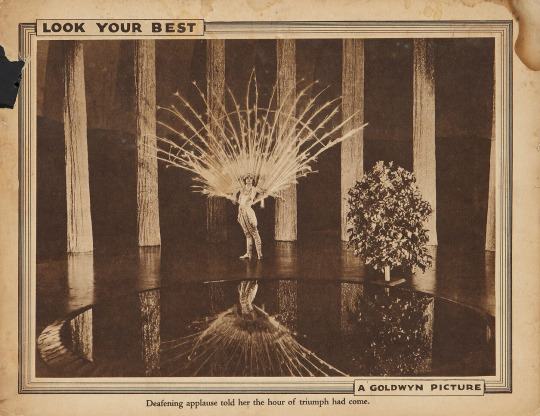
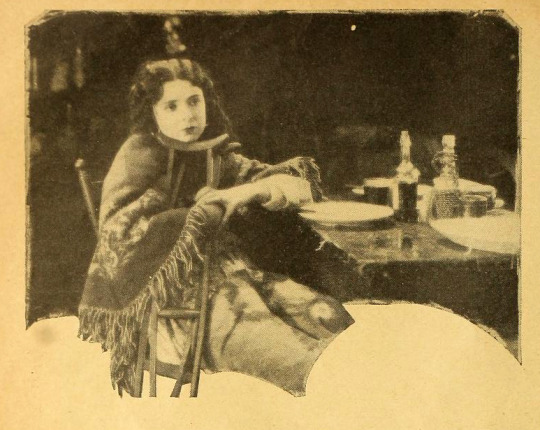
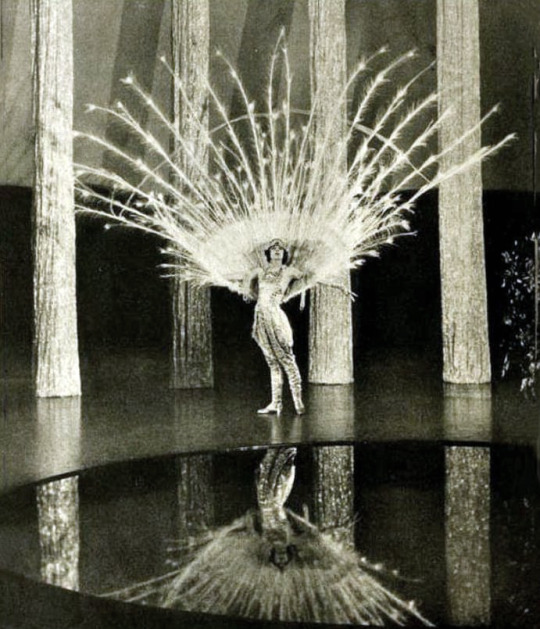

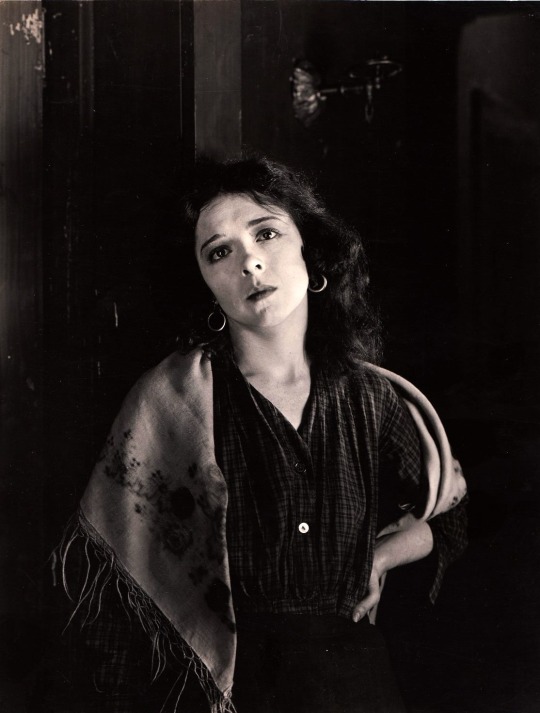

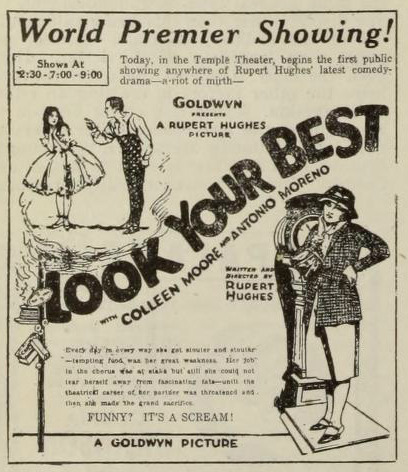
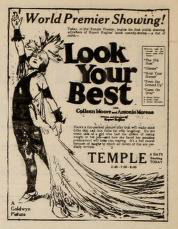
Lost, but Not Forgotten: Look Your Best (1923)
[alternate title: The Bitterness of Sweets]
Direction: Rupert Hughes
Scenario: Rupert Hughes
Camera: Norbert Brodin
Choreography: Ruth St. Denis
Studio: Goldwyn
Performers: Colleen Moore, Antonio Moreno, Earl Metcalfe, Martha Mattox, William Orlamond, Orpha Alba, Francis McDonald, Eleanor Boardman (in a bit role)
Premiere: 18 February 1923, Temple Theatre, Detroit, MI
Status: presumed entirely lost
CW: Dieting / Weight Loss
Synopsis (synthesized from magazine summaries of the plot):
On the streets of New York’s Little Italy, Perla Quaranta* (Moore) dances to the music of her father’s (Orlamond) barrel organ. Unfortunately, Perla’s mother (Alba) has a tendency to grab whatever is at hand for use as a projectile in the midst of arguments with Perla’s father. After one particularly raucous fight, her parents are arrested and sentenced to 30 days. Fortunately for Perla, the owner of a dance troupe, Carlo Bruni (Moreno) scouted her dancing on the streets and hires her to replace a recently fired dancer. The previous girl in Bruni’s “Butterfly Act” was let go after gaining too much weight to do the wirework demanded by the routine. Perla’s privation-induced petiteness is desirable for the role.
Bruni’s struggle with his weight has also apparently gotten in the way of his own work as a dancer. Perla takes well to the role and is a success in the act, which features a number of chorus girls dressed as butterflies flitting across the stage by wire. The stagehand, Krug (Metcalfe), takes a liking to Perla and takes her out regularly as the troupe goes on tour. The now gainfully-employed and avidly-courted Perla has access to all the sweets her heart desires and, in a repeat of her predecessor’s difficulties, she begins to put on pounds. Krug makes an advance on Perla, which she rebuffs. In his bitterness, Krug files Perla’s wires, assuming Bruni will blame the broken wires on her weight and fire her. During the next performance, Perla plummets to the stage and is injured.
Bruni suspects Krug of tampering with the wires, and thrashes him. Bruni is arrested and also given 30 days. While Perla recovers in the hospital, another suitor appears in the form of a baker, Cabotto (McDonald), who buoys her spirits by describing all the different delectations he serves. Meanwhile, behind bars, Bruni envisions a new ballet for the troupe with Perla in a starring role.
When Bruni is freed and Perla is recovered, they reunite and commit to dieting and to each other, via marriage. The new act depicts Perla as a white peacock killed by the hunter, played by Bruni, and mourned by an array of forest nymphs.
(At some point before the final dance number, Perla is reunited with her parents, but, from the synopses, I’m not sure of the order of events.)
* or Quaranti or Moroni based on various reviews
As a side note that I cover more in the annotations below: this plot doesn’t make much sense without a heavy dose of satire, right? The reviews didn’t leave me with a clear idea on whether the film lampoons diet culture or not and, unfortunately for us, unless somebody (maybe some sharp Michigander) makes a lucky discovery, we can’t find out for ourselves!
Transcribed sources & annotations below:
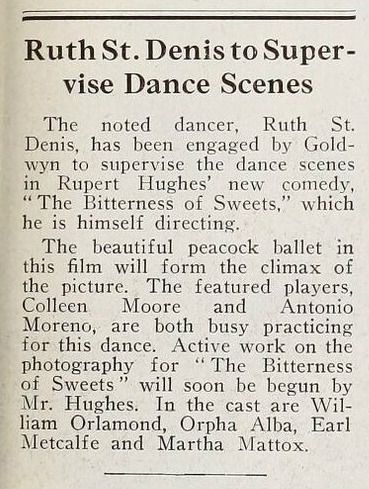
Motion Picture News, April 1922
Ruth St. Denis to Supervise Dance Scenes
The noted dancer, Ruth St. Denis, has been engaged by Goldwyn to supervise the dance scenes in Rupert Hughes’ new comedy, “The Bitterness of Sweets,” which he is himself directing.
The beautiful peacock ballet in this film will form the climax of the picture. The featured players, Colleen Moore and Antonio Moreno, are both busy practicing for this dance. Active work on the photography for “The Bitterness of Sweets” will soon be begun by Mr. Hughes. In the cast are William Orlamond, Orpha Alba, Earl Metcalfe and Martha Mattox.
—
Note: “The Bitterness of Sweets” was the working title of “Look Your Best.”
I hadn’t heard of Ruth St. Denis before now, but seeing what an important role she had in the creation of Modern Dance in America—and that she was a teacher of both Martha Graham and Louise Brooks—it’s an insult to injury that this film appears to be lost. I’m not even sure how many films St. Denis worked on! Many of the reviews below cite the dance numbers as a true highlight of the film too.
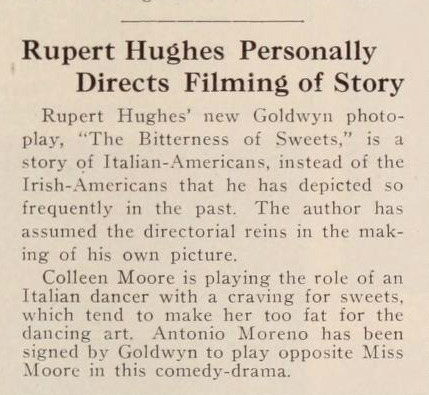
Exhibitor’s Herald, 8 April 1922
Rupert Hughes Personally Directs Filming of Story
Rupert Hughes’ new Goldwyn photoplay “The Bitterness of Sweets,” is a story of Italian-Americans, instead of the Irish-Americans that he has depicted so frequently in the past. The author has assumed the directorial reins in the making of his own picture.
Colleen Moore is playing the role of an Italian dancer with a craving for sweets, which tend to make her too fat for the dancing art. Antonio Moreno has been signed to Goldwyn to play opposite Miss Moore in this comedy-drama.
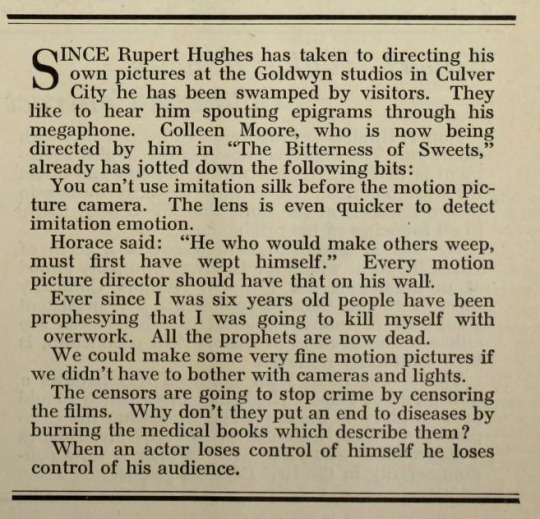
Moving Picture World, 13 May 1922
SINCE Rupert Hughes has taken to directing his own pictures at the Goldwyn studios in Culver City he has been swamped by visitors. They like to hear him spouting epigrams through his megaphone. Colleen Moore, who is now being directed by him in “The Bitterness of Sweets,“ already has jotted down the following bits:
You can’t use imitation silk before the motion picture camera. The lens is even quicker to detect imitation emotion.
Horace said: “He who would make others weep, must first have wept himself.” Every motion picture director should have that on his wall.
Ever since I was six years old people have been prophesying that I was going to kill myself with overwork. All the prophets are now dead.
We could make some very fine motion pictures if we didn’t have to bother with cameras and lights.
The censors are going to stop crime by censoring the films. Why don’t they put an end to diseases by burning the medical books which describe them?
When an actor loses control of himself he loses control of his audience.
—
Note: the timeline for the production to release of this movie is really something. They commenced filming somewhere around the end of April/early May 1922, but it wasn’t released until late February of 1923.
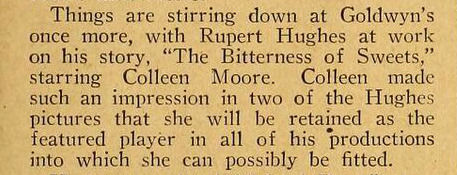
Motion Picture Magazine, June 1922
On the Camera Coast
[excerpt]
Things are stirring down at Goldwyn’s once more, with Rupert Hughes at work on his own story, “The Bitterness of Sweets,” Colleen Moore. Colleen made such an impression in two of the Hughes pictures that she will be retained as the featured player in all of his productions into which she can possibly be fitted.
—
Note: This doesn’t appear to have come to fruition?
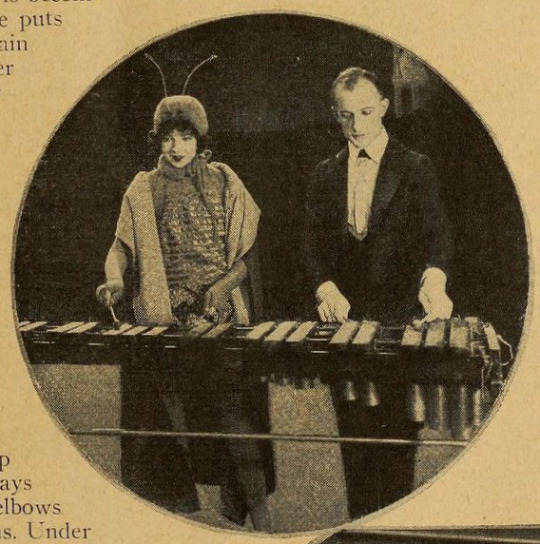
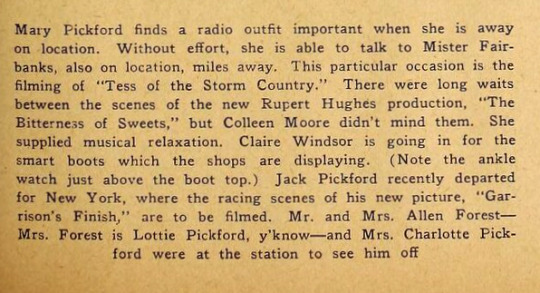
Motion Picture Magazine, September 1922
…There were long waits between the scenes of the new Rupert Hughes production “The Bitterness of Sweets,” but Colleen Moore didn’t mind them. She provided musical relaxation…

Exhibitor’s Trade Review, October 1922
Colleen Moore Sets New Record
Will Be Featured by Five Different Distributing Companies Within Space of Two Months
A record unique in the annals of the motion picture business is being set this fall by Colleen Moore, beautiful and talented young star. Exhibitors who stand by one or another distributing company and who have therefore not had the opportunity to play any of these pictures in which Miss Moore has been featured will note with interest that no less than five distributing companies will offer productions in which she is featured during the coming fall months.
First National will shortly present “Slippy McGee,” the Oliver Morosco production of Marie Conway Oemler’s well known story, in which Miss Moore plays the leading feminine role.
Goldwyn will soon release two pictures in which Miss Moore will be featured. The first will be Rupert Hughes’ production of “The Bitterness of Sweets,” which was personally directed by the author. Tony Moreno plays opposite Miss Moore in this production. The second Goldwyn feature will be “Broken Chains,” the widely advertised $10,000 prize story which was transferred to the screen under the capable direction of Allen Holubar.
Hodkinson has already delivered to its exchanges the prints of “Affinities,” a picturization of the Mary Roberts Rhinehart story of the same name. This is a Ward Lascelle production in which Miss Moore is starred.
Universal announces that Miss Moore will soon be seen in the featured feminine role in “Forsaking All Others,” a drama which has just been completed under the direction of Emile Chautard. It will be released as a Jewel special.
Rounding out the quintet, Vitagraph is now nearing completion of a picturization of the famous old stage success “The Ninety and Nine,” with Miss Moore in the featured role and directed by Dave Smith. This production will also be a special release.
—
Note: Slippy McGee (premiered June 1923, status unknown) , Broken Chains (premiered December 1922, extant), Affinities (premiered October 1922, status unknown), Forsaking All Others (premiered December 1922, status unknown), The Ninety and Nine (premiered December 1922, only 10 minutes of the film survive (available on Undercrank Productions’ Accidentally Preserved Vol. 4))
This item implies that LYB was intended for release in the fall/winter of 1922, though an exact date isn’t given.
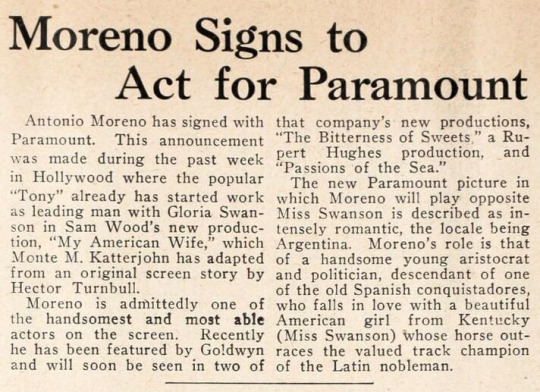
Moving Picture World, October 1922
Moreno Signs to Act for Paramount
Antonio Moreno has signed with Paramount. This announcement was made during the past week in Hollywood where the popular “Tony” already has started work as leading man with Gloria Swanson in Sam Wood’s new production, “My American Wife,” which Monte M. Katterjohn has adapted from an original screen story by Hector Turnbull.
Moreno is admittedly one of the handsomest and most able actors on the screen. Recently he has been featured by Goldwyn and will soon be seen in two of that company’s new productions, “The Bitterness of Sweets,” a Rupert Hughes production, and “Passions of the Sea.”
The new Paramount picture in which Moreno will play opposite Miss Swanson is described as intensely romantic, the locale being Argentina. Moreno’s role is that of a handsome young aristocrat and politician, descendant of one of the old Spanish conquistadores, who falls in love with a beautiful American girl from Kentucky (Miss Swanson) whose horse out-races the valued track champion of the Latin nobleman.
—
Note: My American Wife (premiered February 1923, status unknown), Passions of the Sea (premiered in February 1923 as Lost and Found on a South Sea Island, extant)

Motion Picture News, February 1923
Pre-release Reviews of Features
“Look Your Best ”
Goldwyn—Six Reels
(Reviewed by Charles Larkin)
TO EAT, to grow fat, to spoil one’s career. To starve, to keep thin, to become a great artiste. That is the choice given Perla Quaranta, a little Italian girl portrayed by Colleen Moore, who is one day noticed dancing in the streets by Carlo Bruni, manager of a small theatrical troupe, and who is given the place of the chorus lady who has fallen to the temptation of too many sweets, with the result that the perfect 36 has developed into an imperfect 40 or so. Perla is a success in the act but as she goes from town to town, accepting invitations from Krug, a stage hand, to dine, she also begins to take on weight. Krug, maddened at her coldness, when he makes advances, weakens the wire that holds Perla aloft in a butterfly stunt and she falls to the stage. Krug thought he could tell the folks Perla’s avoirdupois was to blame. Bruni, however, knocks Krug for a goal and gets thirty days for his gallantry. However, thirty days pass soon in some jails, and Bruni is soon out and starting a new ballet with Perla.
And so it goes. It isn’t much of a picture and there is a fight between Perla’s mother and father which takes up much footage and could be eliminated much to the improvement of the story. In fact, the dropping of these two characters throughout would not be missed in the least. To see a boisterous hurdy gurdy grinder jump from jail into a theatre box in a dress suit is not being done these days. There is a very artistic ballet scene toward the end of this picture.
This is not the best thing Rupert Hughes has written and adapted for the screen. Neither is it his best directed picture. Of course, one can’t expect any company to continue releasing masterpieces all the time. We can’t have a “Christian” every day. There have got to be some program pictures once in a while. This is one. It will serve its purpose and is suitable for second-class downtown houses, and there may be many who may find much humor in its fat and thin theme—especially those who are fighting either evil.
The Cast
Perla Quaranta…Colleen Moore
Carlo Bruni…Antonio Moreno
Pietro…William Orlamond
Nella…Orpha Alba
Krug…Earl Metcalfe
Mrs. Blitz…Martha Mattox
Alberto Cabotto…Francis McDonald
By Rupert Hughes. Directed by Rupert Hughes. Scenario by Rupert Hughes. Photographed by Norbert Brodin.
The Story—Deals with the horror in which some folks hold plain good old fat. A chorus girl having attained this terrible state, is fired and Perla, a daughter of Little Italy, is given her place in Bruni’s “Butterfly Act.” Perla made good and went on the road with the show. She also went out to dine with one Krug and began to put on flesh. Krug, a disappointed suitor, filed one of the wires which held Perla aloft in the butterfly stuff. During the act she crashed to the stage. Bruni beats up Krug and gets 30 days. Emerging from jail he starts a new ballet, engages Perla and the two rise to fame.
Classification—One of Rupert Hughes’ problem plays—the problem of keeping thin.
Production Highlights—Colleen Moore’s characterization of the role of the little Italian girl. The crashing of Perla to the stage floor as a result of the villain weakening the wire which holds her.
Exploitation Angles—The title. The eat and grow thin or fat as you will theme offers a chance to tie up with the health department, Y. W. C. A. women’s walking clubs, etc.
—
Note: “Deals with the horror in which some folks hold plain good old fat.” There’s only so much I can assume about the movie’s treatment of weight gain and dieting, as it is lost, but from all the synopses I read, I gotta say as a plot device it doesn’t seem to make much sense? Like, obviously in the performing arts, the expectation to stay at one precise size is stricter than in other fields, but it seems like there is no real logic at play here? I’m glad this reviewer points out that it comes off as Rupert Hughes just hating fat people. Another reviewer mentions a noteworthy lack of satire in the film, and, from the details in the synopses, it seems like this plot would only really make sense if it were a satire or critique on diet culture.
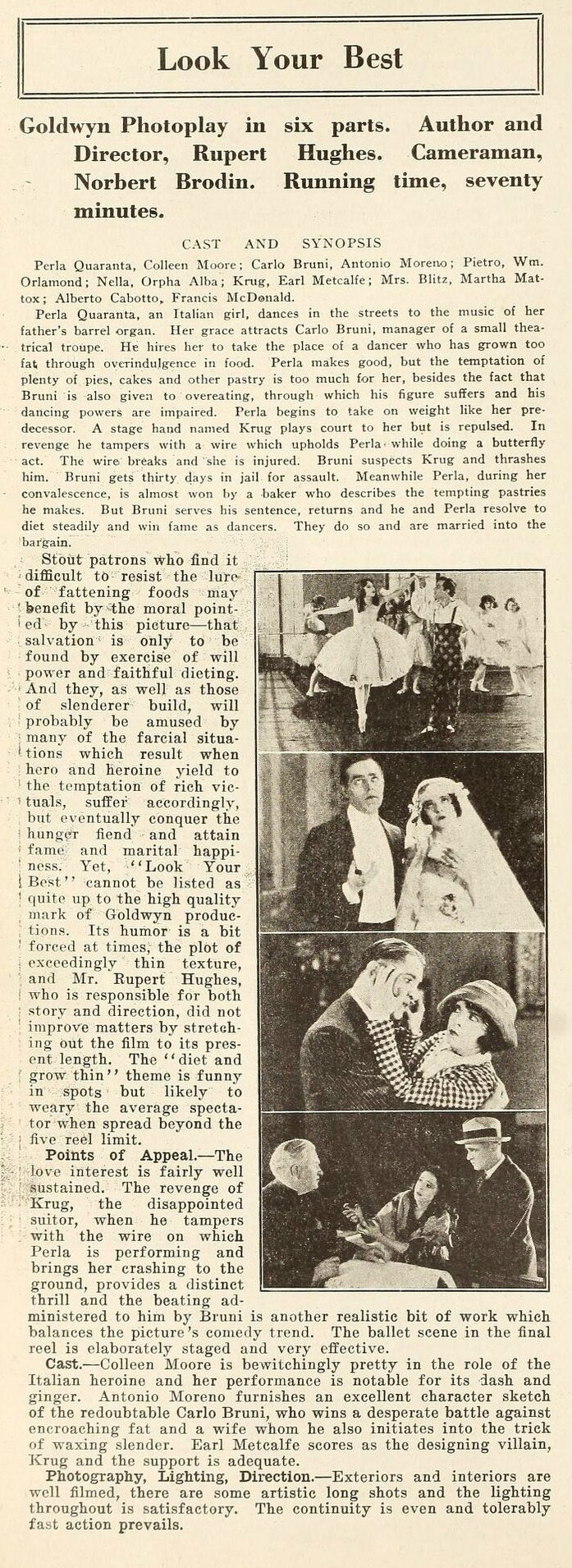
Exhibitor’s Trade Review, February 1923
Look Your Best
Goldwyn Photoplay in six parts. Author and Director, Rupert Hughes. Cameraman, Norbert Brodin. Running time, seventy minutes.
CAST AND SYNOPSIS
Perla Quaranta, Colleen Moore; Carlo Bruni, Antonio Moreno; Pietro, Wm. Orlamond; Nella, Orpha Alba; Krug, Earl Metcalfe; Mrs. Blitz, Martha Mattox; Alberto Cabotto, Francis McDonald.
Perla Quaranta, an Italian girl, dances in the streets to the music of her father’s barrel organ. Her grace attracts Carlo Bruni, manager of a small theatrical troupe. He hires her to take the place of a dancer who has grown too fat through overindulgence in food. Perla makes good, but the temptation of plenty of pies, cakes and other pastry is too much for her, besides the fact that Bruni is also given to overeating, through which his figure suffers and his dancing powers are impaired. Perla begins to take on weight like her predecessor. A stage hand named Krug plays court to her but is repulsed. In revenge he tampers with a wire which upholds Perla while doing a butterfly act. The wire breaks and she is injured. Bruni suspects Krug and thrashes him. Bruni gets thirty days in jail for assault. Meanwhile Perla, during her convalescence, is almost won by a baker who describes the tempting pastries he makes. But Bruni serves his sentence, returns and he and Perla resolve to diet steadily and win fame as dancers. They do so and are married into the bargain.
Stout patrons who find it difficult to resist the lure of fattening foods may benefit by the moral pointed by this picture—that salvation is only to be found by exercise of will power and faithful dieting. And they, as well as those of slenderer build, will probably be amused by many of the farcical situations which result when hero and heroine yield to the temptation of rich victuals, suffer accordingly, but eventually conquer the hunger fiend and attain fame and marital happiness. Yet, “Look Your Best” cannot be listed as quite up to the high quality mark of Goldwyn productions. Its humor is a bit forced at times, the plot of exceedingly thin texture, and Mr. Rupert Hughes, who is responsible for both story and direction, did not improve matters by stretching out the film to its present length. The “diet and grow thin” theme is funny in spots but likely to weary the average spectator when spread beyond the five reel limit.
Points of Appeal.—The love interest is fairly well sustained. The revenge of Krug, the disappointed suitor, when he tampers with the wire on which Perla is performing and brings her crashing to the ground, provides a distinct thrill and the beating administered to him by Bruni is another realistic bit of work which balances the picture’s comedy trend. The ballet scene in the final reel is elaborately staged and very effective.
Cast.—Colleen Moore is bewitchingly pretty in the role of the Italian heroine and her performance is notable for its dash and ginger. Antonio Moreno furnishes an excellent character sketch of the redoubtable Carlo Bruni, who wins a desperate battle against encroaching fat and a wife whom he also initiates into the trick of waxing slender. Earl Metcalfe scores as the designing villain, Krug and the support is adequate.
Photography, Lighting, Direction.—Exteriors and interiors are well filmed, there are some artistic long shots and the lighting throughout is satisfactory. The continuity is even and tolerably fast action prevails.

Motion Picture Magazine, March 1923
Comments on Numerous Productions
LOOK YOUR BEST — GOLDWYN
Rupert Hughes gets off on a different tack in this, his latest expression. He makes a plea to be on the look-out for adipose tissue as a destroyer of beauty. And he argues his point thru a weirdly melodramatic story of a chorus girl who develops obesity and is discharged as a result. A slender girl is taken on and proves a sensation. Comes then a bit of Italian jealousy when a disappointed lover files the wires in the ballet number, causing the little “butterfly” to crash to the stage. Mr. Hughes’s satiric vein is missing here. In fact you wouldn’t recognize his style here at all. It’s breath-taking, now and then, but many of the scenes are clumsily executed and the characters are not deftly drawn. Colleen Moore succeeds in being genuine, as usual, in her portrayal of the ballet girl. And Tony Moreno is a satisfactory lover—of the hot Italian school.
---
Note: Interesting point here that there is a lack of “Hughes’ satiric vein.” I haven’t seen much of his work as of yet, so I don’t know what sort of satire would be typical of Hughes’ work. However the plot details laid out across various reviews and synopses don’t just strain credibility they tear it to shreds, UNLESS the whole thing was a satire on diet culture, but as far as I can tell, it’s just straight-up fatphobia. A shame, for sure, because this sort of story told as a lampooning of diet culture honestly sounds pretty darn entertaining.

Motion Picture Magazine, March 1923
Rupert Hughes went out to the Palm Springs on the edge of the desert to make the opening scenes of the film version of his novel “Souls for Sale.” It suddenly began to rain in the way rain comes down in the desert and the company was stuck there in idleness for a week. Claire Windsor, Richard Dix, Frank Mayo, Lew Cody and other well known actors will be in the cast. It has always been supposed that Maj. Hughes drew the heroine of his story to a certain extent from Claire Windsor, altho, of course, with liberal modifications. It almost went without saying that she would have the part when the story was screened.
The name of Maj, Hughes’ story, “The Bitterness of Sweets,” has been changed to “Look Your Best.” This was the picture in which Colleen Moore appeared as a dancer.
—
Note: Considering the extended timeline between the production and release of Look Your Best, the production of Souls for Sale (premiered March 1923, extant) commenced directly after LYB wrapped. So, Hughes’ second and third feature for Goldwyn premiered within a month of each other, with Souls for Sale being a larger production and more heavily marketed. I’m wondering if holding off on the release of Look Your Best was due to a lack of faith in the final product and a desire not to prematurely tarnish the rep of a writer/director that Goldwyn had just signed on for a lot of pictures? That is, releasing it close to Souls for Sale seems like a smart call because Souls for Sale’s quality and higher box-office potential would likely minimize any doubts about Hughes’ abilities that might arise if his second film for Goldwyn was as underwhelming as reviewers and exhibitors portray it. Alternatively or additionally, maybe the studio deemed LYB a “programmer” after production wrapped and was simply waiting for a better time on their release schedule.
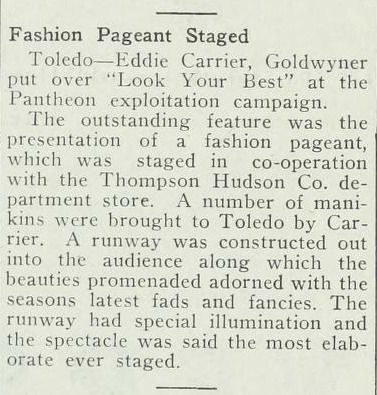
The Film Daily, 30 March 1923
Putting It Over
Here is how a brother exhibitor put his show over. Send along your ideas. Let the other fellow know how you cleaned up.
Fashion Pageant Staged
Toledo—Eddie Carrier, Goldwynner put over “Look Your Best” at the Pantheon exploitation campaign.
The outstanding feature was the presentation of a fashion pageant, which was staged in co-operation with the Thompson Hudson Co. department store. A number of manikins were brought to Toledo by Carrier. A runway was constructed out into the audience along which the beauties promenaded adorned with the seasons latest fads and fancies. The runway had special illumination and the spectacle was said the most elaborate ever staged.
—
Note: There are a number of news items about exploitation schemes for the film that tie in with other local businesses, but, humorously, the tie-ins are with department stores and have to do with fashion and cosmetics, when that seemingly has nothing to do with a movie about vaudeville performers and dieting!
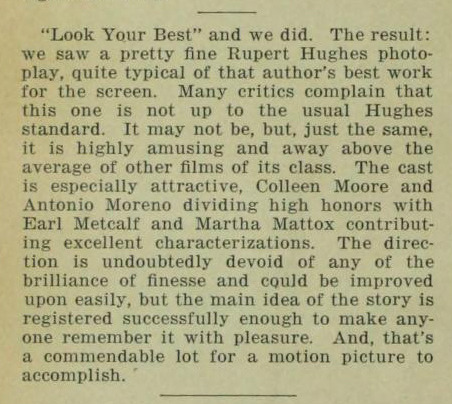
Camera, 30 March 1923
THE SILENT TREND
Composite of Views, Previews, and Reviews of Motion Pictures.
“Look Your Best” and we did. The result: we saw a pretty fine Rupert Hughes photoplay, quite typical of that author’s best work for the screen. Many critics complain that this one is not up to the usual Hughes standard. It may not be, but, just the same, it is highly amusing and away above the average of other films of its class. The cast is especially attractive, Colleen Moore and Antonio Moreno dividing high honors with Earl Metcalf and Martha Mattox contributing excellent characterizations. The direction is undoubtedly devoid of any of the brilliance of finesse and could be improved upon easily, but the main idea of the story is registered successfully enough to make anyone remember it with pleasure. And, that’s a commendable lot for a motion picture to accomplish.

Motion Picture News, April 1923
Elaborate Style Show Put Over with “Look Your Best”
Toledo, Ohio.—The management of the Pantheon theatre, in conjunction with Goldwynner Eddie Carrier, put on an elaborate exploitation campaign on “Look Your Best,” the outstanding feature of which was a fashion pageant staged in co-operation with the Thompson-Hudson Company, a leading department store.
A bevy of beautiful mannequins was assembled, and a runway was built far out into the audience, on which they promenaded with the latest fashion creations. Special lighting and scenic effects were used and a musical score was provided for the occasion. The department store co-operated with a double-page ad, seven full window displays and 2,500 letters to its customers.
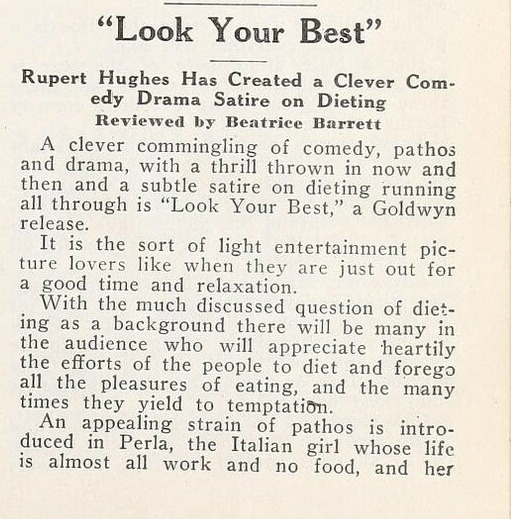

Moving Picture World, April 1923
“Look Your Best”
Rupert Hughes Has Created a Clever Comedy Drama Satire on Dieting
Reviewed by Beatrice Barrett
A clever commingling of comedy, pathos and drama, with a thrill thrown in now and then and a subtle satire on dieting running all through is “Look Your Best,” a Goldwyn release.
It is the sort of light entertainment picture lovers like when they are just out for a good time and relaxation.
With the much discussed question of dieting as a background there will be many in the audience who will appreciate heartily the efforts of the people to diet and forego all the pleasures of eating, and the many times they yield to temptation.
An appealing strain of pathos is introduced in Perla, the Italian girl whose life is almost all work and no food, and her childish pleasure in her first nice clothes. Colleen Moore does well this wistful role. There is always a fascination about life back of the curtain and there are many scenes here of the rehearsals and scenes in the dressing rooms that will attract.
Very beautiful are the scenes of the Butterfly Girls with great gauze wings executing their dance and then suspended on wires flying through the air. The stage sets and the dance which Antonio Moreno and Colleen Moore do at the end of the picture is also very artistic and gives an air of a big production to what at times seems to be simply a comedy.
Rupert Hughes worked up through many laughs to the big thrill of the cut wire and has handled very well these scenes with the girl flying through the air coming right toward the camera—and all the while the audience knows the wire is going to break—and it does and there is a fall that will give them a shudder.
The plot is a gossamer one, and simply a thread which lightly holds together the events of the story—but in a picture of this character you don’t expect much plot. The audience will be chuckling and enjoying each new incident as it comes along.
Cast
Perla Moroni…Colleen Moore
Carlo Bruni…Antonio Moreno
Pietri…William Orlamond
Nella…Orpha Alba
Krug…Earl Metcalf
Mrs. Blitz…Martha Maddox
Alberta Cobatto…Francis MacDonald
Written and directed by Rupert Hughes.
6 reels.
Story
Perla, a half starved Italian girl, is engaged by Bruni to be one of his butterfly dancers because she is so thin. Krug, the wireman, becomes infatuated with Perla. She begins to get fat, and when she tires of Krug’s attentions he files the wire on which she hangs as a butterfly so Bruni will think she is too fat for the part and discharge her. Bruni used to be a beautiful dancer but through love of food grew too fat and could no longer dance. He and Perla both start to diet. He composes a beautiful dance for them and they are a great success. The story ends with their wedding—and the two still dieting.
—
Note: Now, this reviewer thinks the film is a satire of dieting?

Exhibitor’s Herald, 7 April 1923
COLLEEN MOORE IN
LOOK YOUR BEST
(GOLDWYN)
A cheerful little story of an Italian girl who becomes an actress and then has a hard time keeping her job because of overeating. An interesting picture of backstage life, and although not one of Rupert Hughes greatest plays, is quite satisfying. Author: Rupert Hughes; Continuity: Rupert Hughes; Director: Rupert Hughes. Length six reels.
There is just a little over an hour’s pleasant diversion in this latest Rupert Hughes-Goldwyn production. It is a quaint mixture of pathos, humor and drama. The humor borders on the slapstick, while the melodrama is the good old-fashioned “s-death” kind. However, there is the ever appealing Colleen Moore in it, as the interesting little toe dancer, and Antonio Moreno as a ballet master. Add to these William Orlamond, as Pietro; Orpha Alba, as Bella, his wife; Earl Matcalfe, as Krug, the villain; Martha Mattox, ad Mrs. Blitz; and Francis McDonald, as Cabotto, a suitor for Perla’s hand, and you have a cast capable of good things.
At the State-Lake theater, Chicago, where the picture followed the trained seals, it got a few laughs and held the attention of a vaudeville-loving audience. And you’ll certainly enjoy Colleen Moore more and more.
The story concerns Perla, a little New York girl of Italian parentage who goes into Bruni’s butterfly dance act in vaudeville and finds she must deny herself the sweets she loves in order to remain slender. The man who manipulates the wires, failing to win her love, plots to get her discharged for putting on too much flesh. He cuts the wire supporting her, but Bruni discovers his treachery and engages him in a fight, which lands both in jail, but on Bruni’s release Perla is waiting to reward him with her hand.

Screen Opinions, June 1923
“LOOK YOUR BEST”— [Class B] 65%
(Especially prepared for screen)
Story:—Romance of Little Italy, a Girl and a Theatrical Manager
VALUE
Photography—Very good—Norbert Brodin.
TYPE OF PICTURE—Entertaining.
Moral Standard—Average.
Story—Good—Comedy-drama—Family.
Stars—Good—Colleen Moore and Antonio Moreno.
Author—Good—Rupert Hughes.
Direction—Good—Rupert Hughes.
Adaptation—Good—Rupert Hughes.
Technique—Good.
Spiritual Influence—Neutral.
CAST
Perla Quaranti…Colleen Moore
Carlo Bruni…Antonio Moreno
Pietro…William Orlamond
Nella…Orpha Alba
Krug…Earl Metcalfe
Mrs. Blitz…Martha Mattox
Alberto Cabotto…Francis McDonald
June 1 to 15, 1923.
Producer—Goldwyn
Footage—6,000 ft.
Distributor—Goldwyn
Our Opinion
MORAL O’THE PICTURE—If You Would Look Well, Mind Your Diet.
Not Particularly Artistic, but Makes Good Entertainment—Stars Do Well
Scenes in Little Italy, in which an Italian organ grinder and his wife are forced to serve a thirty-day sentence in jail following a knife and china shower, are fraught with comedy, and so also is the initiation of Perla, the pretty daughter, into the stage technique of playing butterfly and being hoisted on a wire to flutter her butterfly wings. Colleen Moore is charming in the role of Perla, and one of the notably good performances of the picture is done by Orpha Alba, who plays the role of Nella Quaranti, Perla’s mother, who, between laughter and tears, chastises her husband, Pietro, with the first article that comes to hand, no matter what the substance is, and then makes parting at the jail “such sweet sorrow.” William Orlamond is the type for Pietro, and Antonio Moreno, as Bruni, whose theatrical grace was spoiled by too much eating, is also very good. Earl Metcalfe, as Krug, elected to serve as Perla’s wire hoister, in love with her and reproachful when he failed to obtain kisses in return for the food that made Perla “not as thin as she used to was,” is all that the role requires—he does well. Francis McDonald is the baker joy and jealous lover, and looks and acts the part. The picture contains some attractive stage scenes with the butterfly girls flitting rapidly past the camera, and there is also an elaborately staged classic dance, supposed to take place in the greenwood, in which Colleen Moore is dressed as a white peacock, which is slain by the hunter, Antonio Moreno, and mourned by the wood nymphs. This is really a very enjoyable feature.
STORY OF THE PLAY
Perla Quaranti, a street dancer, finds herself alone when her father and mother are sentenced to thirty days in jail for fighting. She is offered a position by Carlo Bruni, an Italian theatrical manager, whose specialty is a group of butterfly girls. Perla, filling the place of a girl who got too stout to hoist, grasps good fortune by the neck and eats herself stout also on the bounty of one Krug, a wirehoister. Krug plays her false when he realizes that she loves Bruni instead of himself, and takes revenge by cutting the wire so that during the whirl of butterflies Perla falls to the stage and is injured. The story closes happily with Perla and her parents reunited, and Bruni her prospective husband.
PROGRAM COPY—”Look Your Best”—Colleen Moore and Antonio Moreno
Perla Quaranti’s butterfly days ended with a bang when a jealous lover took revenge for lack of kisses. Don’t miss seeing Colleen Moore, Antonio Moreno and an excellent cast in “Look Your Best,” one of the funniest and most original of recent comedies.
—
Note: This is the only review that adds detail about Perla’s parents. Another reviewer complained that the bits with her parents were wholly superfluous. Other reviewers barely mention that they are even in the film!
Moving Picture World, 9 June 1923
Sells First Showing on the Type Argument
The Temple Theatre, Detroit, does not believe in too much splash, even for a world premier, and gets along very nicely with 100 by 3 for Look Your Best, using two cuts and six lines of snappy stuff about the nature of the play to back up the illustrations. Apparently these illustrations are from the plan book, and they have no strong illustrative value, but the upper one suggests the stage story, which this is, and the lower the growing weight of Colleen Moore, which is the essence of the plot. The selling value lies chiefly in the talk, and here this talk is a quiet little chat about the play with no particular stress, just an intimate tip-off on the nature of the play which is more convincing than a many-adjectived oration could possibly be. It is so good that it might have been put into larger type, even at the cost of one of the cuts. And make a note now that Look Your Best is going to make a wonderful peg for hook-up pages and style shows. Combine the two of them by starting early enough to get your plans all properly laid. There are a lot of similar co-operative angles, but these will be the best bets. -P. T. A.-
Poster blurb: Every day in every way she gets stouter and stouter—tempting food was her great weakness. Her job in the chorus was at stake but still she could not tear herself away fascinating fats—until the theatrical career of her partner was threatened and then, she made the grand sacrifice.
FUNNY? IT’S A SCREAM!
— Note: photo of the interior of the now demolished Temple Theatre, a popular vaudeville venue.
---
Exhibitor’s Trade Review, July 1923
SLOGAN BASIS OF MERCHANT TIE-UP
Madison, Wis.—A merchant tie-up on a “Look Your Best” Week was put across by Dr. Wm. E. Beecroft, manager of the Parkway Theatre, and Goldwynner W.D. Nealand, in connection with the screening of “Look Your Best.” Art Kniseley, advertising manager of the Burdick & Murray Department Store, went in heavily with the theatre management on this “Look Your Best” week.
He gave the picture a splendid window display, using the slogan “Look Your Best” as a sales aid for their clothing, millinery, hosiery and toilet articles. In addition to the window display, Mr. Kniseley ran a sixty-eight inch advertisement in both the State Journal and the Capitol Times, tieing up with “Look Your Best.”
---
Moving Picture World, September 1923
Consensus of Published Reviews
Look Your Best
(Colleen Moore—Goldwyn—6 reels)
M. P. W.—A clever commingling of comedy, pathos and drama, with a thrill thrown in now and then and a subtle satire on dieting.
E. H.—Is a cheerful little story of backstage life. It was written and directed by Rupert Hughes, and although not his greatest play, will be found highly diverting as an hour’s entertainment.
N.—It will serve its purpose and is suitable for second-class downtown houses.
T. R.—The “diet and grow thin” theme is funny in spots but likely to weary the average spectator.
---
Picture Play Magazine, October 1923
Keeping Nature’s Gifts
[excerpt]
Colleen Moore’s diet depends upon whether she is putting on flesh for a picture or taking it off. She lived practically on lemon-juice for two weeks, losing ten pounds at the start of “Look Your Best.” For the last scenes she had to regain her avoirdupois, so she went to bed for a week, drank milk-two or three quarts a day and ate cakes and everything.
—
Note: I hate this.
---
Exhibitor’s Herald, 24 November 1923
Goldwyn Cosmopolitan
Look Your Best, with Colleen Moore. —A very good picture that failed to score at all at the box office. I have played ten of these pictures, losing money on eight, breaking even on one, so I really will be glad when they are over with. The advertising matter is my greatest drawback, for I’m a little fellow and can’t afford an artist to make my lobby and have to use their stock stuff, which is bum considering the attractions they represent. Pretty enough, but do not run true with the films. Seven reels.—Hugh G. Martin, American theatre, Columbus, Ga.—General patronage.
Look Your Best, with Colleen Moore and Antonio Moreno.—Two dandy stars wasted in this. Rupert Hughes was unable to convince an audience of movie fans what he was driving at. Lacked interest all the way. Not worth bothering about.—Ben L. Morris, Temple theatre, Bellaire, Ohio.—General patronage.
---
Moving Picture World, December 1923
LOOK YOUR BEST. (6 reels). Star, Colleen Moore. A very ordinary picture that I played on a Saturday night and put in a strong line of fillers and in that way escaped censure. You can play this, but be careful of your accompanying selections and buy it right. Usual advertising brought good attendance. Draw health seekers and tourists. Dave Seymour, Pontiac Theatre Beautiful, Saranac Lake, New York.
LOOK YOUR BEST. (6 reels). Star cast. Nice little comedy-drama. Very light in construction. Seemed to please. Had fair attendance. Draw all classes in town of 1,000. Admission 15-25. Jack Kaplan, Rivoli Theatre (378 seats), South Fallsburg, New York.
---
Best Moving Pictures, 1922-1923
LOOK YOUR BEST. Produced and distributed by Goldwyn. Six reels. Released February 18, 1923. Cast: Colleen Moore and Antonio Moreno. Director, Rupert Hughes. Story of a chorus girl who tried to keep thin.
---
The Educational Screen, February 1924
THE THEATRICAL FIELD
LOOK YOUR BEST (Goldwyn)
Colleen Moore and Antonio Moreno demonstrate the tragic fact that life is very bitter to the lover of sweets when his job depends on his remaining thin. Fair entertainment, making no demands on either actors or audience.
---
Motion Picture Magazine, November 1924
Every Little Bit Helps—to Stardom
By HARRY CARR
[excerpt]
Eleanor Boardman came to the old Goldwyn lot and jumped at once into the top line by a tiny scene in Rupert Hughes’ The Bitterness of Sweets, in which she fainted in a theater box.
—
Note: Given what I noted earlier about the release dates of LYB and Souls for Sale, finding out that a bit role in LYB (here referred to by its working title) led to Eleanor Boardman’s starring role in the latter film is fascinating. Boardman likely filmed her single scene in LYB months before production started on Souls for Sale, which she is the star of. But, because the release of LYB was delayed, Boardman had a bit role and a starring role on screens within a month of each other!
#Look Your Best#The Bitterness of Sweets#lost film#silent comedy#silent era#silent film#silent movies#1920s#1922#1923#Rupert Hughes#Colleen Moore#antonio moreno#eleanor boardman#classic movies#classic film#american film#movie magazine#film magazine#Souls for Sale#ruth st. denis#film history#lost but not forgotten
15 notes
·
View notes
Text
what did you like most of milano?
well



#ngl that metro station wasn't my destination and i came back to take the pics#there were ads with fedez dargen sangiovanni and a lot more#but these ones 💖💖💖#alba rambles#alba goes to italy#italian bastards
3 notes
·
View notes
Text
The final night of Sanremo is happening tonight, and with it we’ll find out who will get first refusal to represent Italy at Eurovision! It’s always a bit of a rush ranking Sanremo songs with how quickly the week goes by, but here’s my feelings based on first impressions:
Rosa Chemical – Made in Italy
Sethu – Cause perse
Madame – Il bene nel male
Lazza – Cenere
Elodie — Due
Articolo 31 – Un bel viaggio
Olly — Polvere
Gianluca Grignani — Quando ti manca il fiato
Ultimo — Alba
Colapesce DiMartino – Splash
Giorgia – Parole dette male
Will – Stupido
Colla Zio — Non mi va
Mara Sattei — Duemilaminuti
Marco Mengoni — Due vite
Modà – Lasciami
Leo Gassmann — Terzo cuore
LDA – Se poi domani
Shari – Egoista
Cugini di Campagna — Lettera 22
Paola e Chiara – Furore
Tananai – Tango
Ariete — Mare di guai
Coma_Cose — L’addio
Anna Oxa — Sali
Gianmaria — Mostro
Levante – Vivo
Mr. Rain — Supereroi
I didn’t have time to follow the shows live, instead just watching the performances from night one and two the morning after the show. I enjoyed night one well enough, but found the night two songs much stronger, broadly speaking! All my top four came from there!
My absolute favourite entry this year is Made in Italy. I was hooked on this song just from the guy in the orchestra doing the announcer bit at the start, and it only got better from there! I love the unique sound it's got, the electro swing beat is very catchy and works unexpectedly well with the rap! It's got a chaotic energy to it, there's a lot going on, yet it never feels messy. Though I have to admit I nearly lost it when he started scatting! The song moves at such a pace and I enjoy every second of it, so it ends up feeling much shorter to me than it is! I could honestly listen to this on repeat. And I absolutely love his aesthetic, his outfit was so good.
There’s not as much separating the rest of my top five. I really enjoyed Cause perse, it’s got that pop punk sound to it, very energetic, it gets me hyped up! I only wish it were longer! Next, I loved Madame’s song Voce in 2021, and still listen to it regularly, but I might honestly prefer Il bene nel male. The sound is exciting and a little tense, it draws me into it. I think the production is great, and Madame’s voice is fantastic, she really knows how to perform. Speaking of good production, Cenere is one of the best produced songs here. I especially love that isolated bass right before the chorus, and it helps that I also really like the sound of Lazza’s voice. My final stand out from this selection is Elodie with Due, I don’t think it’s as strong a song as her previous entry, Andromeda, but I still enjoyed it a lot, and Elodie is a fantastic artist.
I would love to see any of these five songs at Eurovision, but, as usual, Italy is pretty spoiled for choice! There’s plenty of other great songs further down my list which could serve them very well at the contest. I reckon they’ve definitely got the quality here to maintain their top 10 streak, and I'm excited to see what they send!
#eurovision#esc2023#nf ranking#italy#actually not over Rosa Chemical#I looked him up on wikipedia briefly and apparently the second part of his name comes from My Chemical Romance?#it literally keeps getting better#just to be clear this ranking is based solely on night one and two performances#I haven't watched any of night three#I ended up watching Malta's semi final instead#it was actually a lot better than I was expecting#several songs I did not care for I enjoyed with proper staging#my overall feelings didn't change though I'm still hoping for The Busker#Today is going to be interesting#I'm going to see the rugby with Scotland playing Wales#very excited for it#but I don't know what time I'll be home since we're having tea out#my plan is to tune into Sanremo and catch up with whatever happened in the other shows while I wait for it to finish#I love my hobbies so much#but it pains me that 6 nations season and esc national final season have to overlap#I wish I had more time so I could just watch everything
2 notes
·
View notes
Text
“…Both Vergil and Livy begin by putting down Homeric roots and anchoring their stories in the Trojan War. That makes a good deal of sense from a mythic perspective: the Iliad and the Odyssey were the most illustrious legends of the Hellenic world and so it made sense for the Romans, looking to claim a place in the Mediterranean, to make that claim through connection to this most illustrious of tales… And so both Vergil and Livy begin their story with Aeneas and his plucky band of Trojan refugees, fleeing the fall of Troy (though interesting, while Vergil tells the tale as a harrowing escape, Livy politely suggests that perhaps Homer’s Achaeans let Aeneas go, Liv. 1.1).
Aeneas (son of Aphrodite/Venus and a mortal man, Anchises) does appear, by the by, in the Iliad, though he isn’t a particularly notable or impressive hero (naturally Vergil will embroider Aeneas until he is presented as the equal of an Achilles or Odysseus because…well, wouldn’t you?). The Aeneid follows (with the aid of a major flashback) Aeneas as he shepherds his surviving Trojans from Troy to their prophesied new homeland in Italy (with a minor stopover in Carthage) and then covers also the war that breaks out between Aeneas’ Trojans and the local inhabitants (the Latins) when he arrives. Vergil cuts off at the climactic moment of the war (which in turn presents Aeneas as rather morally grey, a feature that is also present, as we’ll see, in Livy’s retelling of Rome’s legends), but Livy provides the denouement.
After a period of conflict (Livy presents two different versions of the exact sequence), Aeneas ends up married to Lavinia, the daughter of Latinus, king of the Latins (Livy calls them the Aborigines – lit, ‘the native inhabitants,’ Vergil the Latins; in both cases Latinus is their king) and the Trojan exiles and Latinus’ people form a single community at Lavinium, which in turn founds a colony at Alba Longa, both in Latium (the region of Italy in which Rome is, although note we haven’t founded Rome yet).
We then fast forward a few generations. Rhea Silvia, a priestess of Vesta at Alba Longa gives birth to twins, Romulus and Remus by (Livy expresses some doubt) the god Mars. The twins are exposed (for complicated royal-family-drama reasons we needn’t get into) and rescued by either a she-wolf or a woman of ill-repute (Livy isn’t sure which on account of Latin lupa having both meanings and clearly both legends existed, Liv. 1.4) and raised among shepherds in the hills of northern Latium. More politics ensues, Romulus and Remus, having grown to adulthood, right some wrongs in their home city of Alba Longa and set out to found their own city.
At which point Romulus promptly gets into a fight with and murders Remus over who is going to be in charge (this sort of intense moral ambiguity where the venerated legendary founder figures are also quick to violence and deeply flawed is also a feature of the Aeneid and can be read either as a commentary on Augustus or as some lingering Roman discomfort with their own recent history of civil wars running from 88 to 31 BC; we are not the first people in history to have very mixed feelings about how well people in our country’s past lived up to our ideals).
Crucially, Romulus forms his new settlement (prior to the fratricide) out of – as Livy has it – “the excess multitudes of the Albans and Latins, to which were added the shepherds” (Liv. 1.6.3). After this, desiring to increase the population of the city, Romulus sets a place of refuge in the city so that “a crowd of people from neighboring places, altogether without distinction, free and slave, fled there eager for new things” (Liv. 1.8.6) and were incorporated into Romulus’ growing city. Livy approves of this, by the by, declaring it the first step towards rising greatness.
Romulus quickly has another problem because all of these new settlers were men, so he concocts a plot to carry off all of the unmarried women of the neighboring people, the Sabines – an Umbrian people (we’ll come back to this, for now we’ll note they are ethnically and linguistically distinct from the Latins) – who lived in the hills north of Rome under the guise of a religious ceremony (Liv. 1.9-13). At a festival where the Sabines had been lured to under false pretenses, the Romans abduct and forcibly marry the Sabine women, while using hidden weapons to chase away their families (I should note Livy goes to some length to assure the reader that the captured maidens were subsequently persuaded to marry their Roman captors, rather than forced (Liv. 1.9.14-16), though what choice he imagines the unarmed, captive women to have had is left for the reader to wonder at in vain; in any event, we need not share Livy’s judgement or his effort at patriotic euphemism and may simply note that bride-capture is a form of rape).
The Sabines naturally go to war over this but (according to Livy) a peace is mediated by the captured women (according to Livy, unwilling to see their new husbands and old fathers kill each other) and the two communities instead merge on equal terms. In the midst of all of this, Livy does have Romulus set down a set of common customs for his people, which he thinks to have been mostly Etruscan (Liv. 1.8.3), the Etruscans being the people inhabiting Etruria (modern Tuscany) the region directly north of Rome (Rome sits, in essence, on the dividing line between Latium to the South and Etruria to the North).
Now we want to note two things here from this high-speed trip through the first few chapters of Livy. First is the deep ambivalence towards Roman violence here. Livy presents Rome as a city founded on fratricide, conquest, rape and sacrilege. Livy occasionally attempts to soften the impact of these legends (particular with the Sabines), but only so far. This isn’t really the place to unpack of all of that but suffice to say that I think that Livy’s willingness to open his history of Rome – practically an official history of Rome – so darkly speaks to a literary project still attempting to come to grips with the stunning civil violence which had gripped Rome for Livy’s entire adult life and had, as he wrote, only recently ended. And one day we also ought to come back and do a deeper look at how women function in Livy’s legends and histories (Livy’s account becomes much more properly historical as he gets closer to his own time); women, mostly Roman women, suffering (often sexual) violence so that in their sacrifice the Roman state might be enhanced is a repeated motif in Livy (e.g. Lucretia, Verginia).
But more directly to our topic today, I want to note at this point exactly the sort of society Livy is imagining the earliest Rome, under its first king Romulus, in particular that it consists of a lot of different peoples and heritages. We’ll come back to exactly who all of these peoples are (historically speaking) in a moment. But Livy and Vergil first create a Trojan-Latin fusion community, which produces both Romulus and Remus and their initial core of settlers (mixed in with other, apparently purely Latin communities), who then gather up shepherds from all around, and then invite literally anyone from nearby communities to join them (which must include Etruscan communities to the north as well as Umbrians and Falisci of various sorts from the hills) and then finally fuses that community with the Sabines (an Umbrian people).
So we have our very first Romans, as the first Senate is being set up (1.8.7) and the very first spolia opima – the prize for when one commander defeats his opposite number in single combat – being won (1.10.7) and the very first temple being founded in the city (1.10.7). And those very first Romans, as Livy imagines them, are not autochthonous (that is, the original inhabitants of the place they live), nor ethnically homogeneous, but rather a Trojan-Aborigines-Latin-Faliscian-Umbrian-Etruscan-Sabine fusion community. For Livy, diversity – ethnic, linguistic, religious – defines Rome, from its very first days.”
- Bret Devereaux, “The Queen’s Latin or Who Were the Romans? Part I: Beginnings and Legends.”
11 notes
·
View notes
Text
i've got some headcanons and i want to share them
- after the wedding jane and rafael take their honeymoon and go to italy. mateo flies to new york with ro and xo so he doesn't feel left out of the traveling and gets to have some fun too. in italy jane and raf find his birth parents bakery by chance and everyone thinks rafael is his father because he looks just like him. the family member (probably a niece) who took over shows them around and they bake together and laugh and cry a lot and vow to come back with the kids someday. they spend the rest or the time just being at peace at last, walking around and holding hands.
- that christmas mateo insists on going back to new york because he had a lot of fun and they give in since lina is there too and they have the money to go now. jane has never seen real snow before and when she kisses raf under it while waiting for rogelio to pick them up, she understands the difference. she's also never been that cold before so he wraps his coat around her and she puts her freezing hands under his shirt. mateo has seven sweaters and two jackets plus a hat, scarf and mittens on because jane was worried he'd get cold.
- lina's baby is a few weeks old by then and rafael starts to change his mind about not wanting more kids when he watches jane hold the tiny baby.
- when they get home after new years day advanced reader copies of jane's book are moving around to reviewers and booksellers. rafael is still torn about quitting his job because he enjoys it but he also can't stop thinking about the bakery in italy and starts baking all the time, something he had never done before and is actually really good at and calms him down when he's stressed out.
- jane's book is released in early march. she's been feeling weird and nauseous for a bit but blames it on nerves about the release and all the changes going on until she passes out and alba makes her take a pregnancy test. she thinks the idea is ridiculous because raf is sterile so she is SHOCKED when it's positive. she is so overwhelmed with emotions because while she and raf opened the conversation to adoption again it's still a distant idea and they had never considered this. she doesn't even know how to tell him so she just bursts into tears when he gets home and blurts it out. he just crosses the room and holds her for a long time.
- they're quiet about the pregnancy because they know it's delicate and a miracle so it isn't until jane starts to really show even over loose clothes that they tell petra and the kids. rafael decides to finally quit the real estate job when jane gets busier with book proceedings as her success climbs AND she's pregnant so he lowkey becomes a stay at home dad but not before finding a perfect house for all of them to move into before the new baby comes.
- this pregnancy is different than the one with mateo in almost every way but it also brings back those memories like they can joke about how h*rny the hormones make jane and she finally opens up about how it was like that the first time too. and all those differences they used to have don't exist anymore so all that matters is making sure jane is comfortable and the baby is healthy. the pregnancy is a little harder this time just cause jane is older and gets tired easier but otherwise it goes as smoothly as possible. the move to the bigger house is really easy cause they use movers who do all the work which makes jane feel bad so she gives them a huge tip but it's okay cause her book is on the bestsellers list.
- when she goes into labor it's scary because they never experienced this part alone and together. it happens in the middle of the night and mateo is too excited for 3 am so they have to drop him off with alba on the way to the hospital. rogelio and xo get on a plane the second they get the call and the whole family is there when she's born. the baby is a girl and they name her milagro, which means miracle in spanish (and the names mateo and milagro are cute together) so now mateo has three sisters and he LOVES it.
- eventually jane's books obviously start being adapted for televison and rafael opens his own bakery which his business and hospitality background is still helpful!!
#jane the virgin#jane the novela#jtv#jafael#jane x rafael#txt#i know nina is the name fandom chose for their daughter#but i like mine better wjsjshja
124 notes
·
View notes
Text
Hungry Hearts - a Study in Codependency
Hungry Hearts is a film that confused me on first view. I watched it a few days ago, mostly because I am a fan of the Star Wars sequel saga but had never seen the protagonist, Adam Driver, in another role.
The funny thing is that on awakening the day after watching the film, I came to a conclusion quite different from most comments I had read online.
Watching “Hungry Hearts” was difficult for me because it contained a lot of triggers on a personal basis; but more about that below.
The story is essentially a thriller, about a man despairing when he has to find out that his wife has a distorted personality which threatens the life of their son.
The film concentrates very much on Mina, the female protagonist: she is the first person we see and she dominates most scenes, so she is who seems to be at the center of the story. But the conclusion I came to was that this is not Mina’s story, but Jude’s.
Jude’s characterization is that of a somewhat awkward and insecure person to say the least. He meets Mina in the bathroom of a restaurant where they both accidentally get stuck due to a jammed door; Jude suffers from diarrhea right then and this is the very first experience they share.

Honestly, who hooks up after an experience like that? I suppose anybody would be terribly embarrassed, not turned on. But in the very next scene we already see Jude and Mina in bed, asleep after a sexual encounter and gracelessly apart from one another.
Mina, who comes from Italy, then learns that her job requires her to travel back home. Jude, unwilling to let her go, seduces her and comes inside of her although she begs him not to. When Mina learns that she is pregnant, he proposes to her.
At the marriage party Jude sings an Italian love song for Mina, which is endearing to everybody but the bride, who looks embarrassed. Despite the fact that Jude learned the Italian text of the song for her (he had previously confessed that he does not speak the language), this scene foreshadows that Jude knows next to nothing about Mina: the song he sings is in Neapolitan, while her Italian accent indicates that her origins are elsewhere. (Alba Rohrwachter, the actress, is from Florence.)
During the marriage party Mina also gets to know Jude’s mother, whom, as she tells Mina, he purposely avoids, which is odd since she seems a nice enough person.
Mina, we learn as the story goes on, is not only a vegan but has very distinct ideas about physical and spiritual health. A psychic tells her that she is carrying an “indigo child”, i.e. a child that will have extraordinary paranormal capacities. The young woman is adamant to give birth at home, and when she does not manage, she has to be brought to the hospital where the child is born through Cesarean section.
In the following months, Mina obsesses about her seemingly “special” child. She hardly leaves the house, ignores the many calls from friends and acquaintances, stuffs every angle of the house with cloth and cushions, and feeds the baby (whose name, ironically, we never learn) with special food made from vegetables she grows herself, additionally to a special “cleansing oil” which is supposed to be particularly nourishing.
Jude grows increasingly frustrated and worried, and at the first occasion when Mina is not in the house, he takes his son to a pediatrist who confirms him that the child is not growing properly. Jude starts to feed the baby with a more nourishing diet. As Mina finds out about this, the conflicts between him and his wife intensify; Mina accuses her husband of not “trusting her”, while she is adamant that being the mother, she knows best what is good for the baby. Jude then starts to feed the baby secretly.
After a while, Jude’s mother Anne learns about the situation. We learn she was not present during pregnancy and birth, that she saw her grandchild only when he is already a few months old, and that her son does not want her to enter his house. He says to her that things are normal, that Mina is just going through a “phase” and that he and he alone will take care of his family. But as things deteriorate, he has to spirit the baby away to Anne to save him from Mina. His wife, distrusting both husband and mother-in-law, gets the child back by force and takes legal action to get the child’s father off her back.
The story ends in tragedy: Jude learns that Mina is dead. His mother shot her in her sleep, convinced that it was the only possibility to save her grandson. Jude is left alone and traumatized, but at least he has his son back in his care.
~~~~~~~~~~~~~~~~~~~~~~~~~~~~~~~~~~~~~~~~~~~~~~~~~
As odd as the story may seem, I am by now convinced that it’s not about crazy alternative health methods, bad motherhood or an unhappy marriage, but the story of a man with strong codependency issues.

The critical look in the mirror already suggests that Jude is not exactly happy with himself. He looks somewhat odd, and he is a timid, oversensitive man. He hooks up with a young woman he hardly knows only because a ridiculous circumstance forced him to share a conversation with her. When he learns she has to leave him, it does not occur to him to simply propose to her: he impregnates her first to raise the stakes that she will say yes.
The sad thing is that we see repeatedly that Jude is, at heart, an affectionate and caring person. He wishes for someone he can love and take care of; he denies Mina’s mental condition as long as he can, until the danger for their son becomes too obvious.
As he brings his child to the doctor, he carries it on his chest the way a woman would, visibly taking over the role Mina is unable to cope with; the child obviously brings out his caring and nurturing side, while Mina makes her motherhood all about herself.

It is difficult to say what Mina’s problem is; her mother is dead and she has no connection to her father. At their wedding, she is practically alone among Jude’s friends. The thought that her child is or will be something special becomes obsessive with her. And Jude is not strong enough to accept how weird and even insane the whole situation has become; he believes they will manage together and does not realize that he and Mina have nothing in common but their baby.
That his mother Anne in the end simply kills of his wife seems absurd, but I believe it to be the key scene: Jude’s own mother is, in my eyes, a disturbed person. Jude obviously does not know about personality disorders, but he must have had a reason for not wanting to include his own mother into their lives.
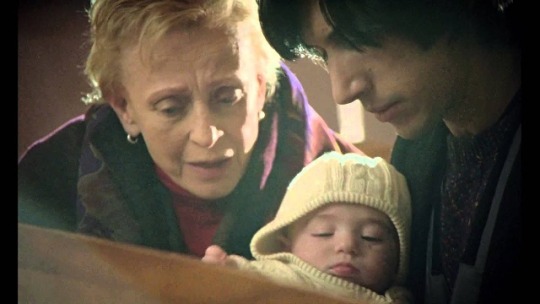
To me, Jude is obviously a codependent person; insecure, naïve, but essentially harmless. He wants nothing but a normal, healthy life with a family of his own, but his history with his mother made him choose (as is often the case) a partner with similar issues. Mina is not a drunkard or junkie, but codependency mostly bonds the dependent person to someone like that; it is possible that Anne is an ex alcoholic, which would explain her son’s rejection of her. Mina does not eat meat, which may have made him suppose that she avoids all kinds of toxic substances; but an avoiding attitude, too, can border on insanity if the person pursues this course at all costs.
Hungry Hearts was triggering for me because I know what it means to grow up and be forced to live with a person with a personality disorder and developing copedendency: the denial, the lack of self-esteem, the strong attachment to someone even after only a short personal contact, the pretense that “everything is normal, this is just a phase”, the hope that the other will “recover”, the desperate desire for normalcy are things I know all too well. Personality disorder is a subject by far too little known publicly, disturbing and hard to diagnose.
Social assumptions go like this: a mother loves her child and knows what’s best for it. A man is inclined to violence and never “gets” his own children. Love will see it through.
Hungry Hearts takes these prejudices and turns them upside down: we see a mother who almost lets her child starve, a father desperate for its safety and yet willing to be patient and let her have her own way as far as possible; and as for love, how much can these two have loved one another when they hardly were acquainted? Jude wanted a family of his own, perhaps he was scared (or had enough) of being alone, so he grasped his first opportunity. He might have learned to love his wife truly during marriage, but with a disturbed person, he hardly had a chance. Jude remains torn between wife and child until his own mother, ironically, relieves him from his torment, but replacing it with another: he is now a young widower whose mother is convicted for murder.
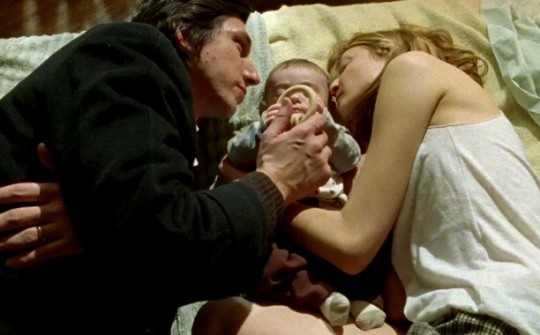
This is my own interpretation and of course it’s hugely personal due to my own story. Most people do not know about personality disorders, and they may grow up with or know such people for years, maybe decades, never understanding what is going on, putting up with “compromises”, making excuses for them and bearing their abusive behavior with patience, only making things get worse and worse. Indulgence and forbearance from others are the last things disturbed persons need, having no understanding of their own self and no healthy social skills, basically living only in their own heads. I never found whether there is a possibility to cure them, but from own experience I can only say that trusting them even to the least degree leads nowhere except to further abuse by them.
Jude is right when he says to his mother that he and his child are all Mina has, but still that does not justify her toxic behavior. Anne, too, plays with fire: she knows she has her highly disturbed, vegan-living, nourishment-obsessed daughter-in-law in the house, and she cooks meat right before her eyes; she calls Mina insane only a few days before killing the young woman. We learn then that Anne is aware that she was not a good mother to her son and that freeing him of his mind-sick wife is, for her, a desperate measure trying to make amends, additionally to the only way she saw to save her grandson. She hints that she had hoped her son had “forgiven her”, which could further emphasize her awareness of her failure as a mother - as I already assumed, perhaps due to an addiction.
A personality disorder is a psychiatric diagnosis which is much more serious and dangerous than PSTD, a personal crisis, a bout of depression or something similar; it roots deep in the person’s psyche and poisons their own life as well as that of the people around them. An incisive experience like married life and or motherhood can trigger this personal weakness additionally, because the disturbed person is additionally stressed and, having the personal maturity of a child, is subconsciously aware of not being capable to handle the situation. Disturbed persons can seem normal and even quite nice in everyday life, but the more stressful and extreme a situation, the more their weakness and detachment from reality become evident. Childishly determined not only to make the best of their lives but to live them to some extreme, in a way that is wholly their own, they are the least likely to accept that something is wrong with them. Hence my interpretation of Mina’s, and also Anne’s, idea of what they believed was “the best” for the child.
On first view, Jude seems the bad guy, the perpetrator: he seduces Mina, practically pushes her into becoming his wife, lets his child be brought into the world through section against her will, yells at her and beats her once during a quarrel; in the end he separates mother from child, which from the point of view of any devoted mother would seem like the cruelest thing anyone could do. But he does so in bright daylight, on his own, and he speaks to his wife telling her that it is only a temporary arrangement. Mina takes the boy away from his father with the aid of the police, in the middle of the night and never wasting a thought or a look for him: the officer shows him an official statement claiming he hit her and is thus unfitting to be a father. The physical evidence of the child’s small, starving body is obviously never officially checked: being the man, Jude is automatically seen as the bad guy and he has no chance to put up a fight.
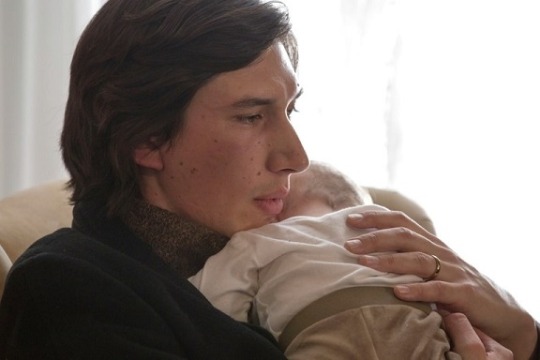
But this is, essentially, the crux of the matter: a codependent person is not to be afraid of. Codependents are weak, insecure, and often come over as needy, but they are not treacherous or irresponsible. They sometimes seem angry without reason but the truth is that they are patient (or better: they were groomed by their abusers to bear their extreme behavior in patience) and people from the outside usually get to see their outbursts only when the last drop falls. Hardly anybody is aware of what went on before, because codependents are so used to denying the abuse and hiding it away. Jude is essentially a passive person, reacting instead of acting, surviving instead of living. His illusions of being a normal husband and father shatter before his eyes one by one.
One of the scenes I found most disturbing was Jude’s desperate attempt to get help from a social worker, who could only offer him that a mother must be exposed publicly to gain proof for her behavior, so that the child can be separated from her; but Jude knew well that he had little time and that his son’s life was at stake. The helplessness of an official social worker in such a situation is frightening, based on the social conviction that a mother should not be separated from her child unless in a very critical case, and even then, only with ample given proof. Again, the underlying assumption is that a mother “loves” her child and that a father pretending that she is harming it cannot be trusted. The social worker then suggests to Jude to bring the baby to his grandmother for his safety, but she also warns him that technically, this course of action would be kidnap. She does not even dare to speak about it to him in his office but does so in private, running after him in the street at the end of their interview. That Jude risks being called a kidnapper and entrusts his child to his estranged mother only accentuates his despair.
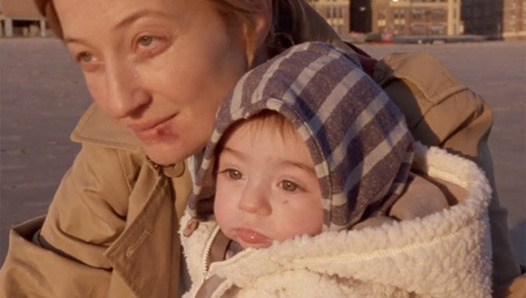
Now some may see me as a cruel person who cannot enter a mother’s sentiments, but I watched the film from the point of view of the child, and I can confirm to you from my experience that a disturbed mother can be threatening health, sanity and the very life of the creature for which she is responsible. The way Mina “lives for her child” may appear heart-wrenching, but it flat-out denies anybody else’s feelings - the father’s, the grandmother’s, even the child’s. Disturbed mothers “love” their children with a clinginess that is suffocating for them, reason being that they believe that at least of their own children they will never have to be afraid, since these are their “own”. They will painstakingly watch, suppress and fear any and every sign of independence from their children’s side as they grow; they mistake their children’s dependence on them for trust and, thus, love. Mina is dependent from her husband at the beginning of their marriage; making their relationship about the child’s dependence from her is perhaps her attempt to shift the dynamics, proving that she does not know love without dependence herself.
In this case, the baby mercifully at least never experiences psychical abuse because his mother dies before he is capable to think. Jude, too, due to his short acquaintance with Mina is spared the usual brainwashing and endless cycle of guilt-trips and condescension disturbed people usually torment their victims with, often gloating at their pain.
Superficially seen, “Hungry Hearts” may seem a drama, or thriller, working with bizarre elements. But from the point of view of an ex codependent (at least I hope I will never go there again!), who has known coexistence with personality disorder first-hand, it’s shockingly accurate and deeply disturbing in its intensity and realism.
The hearts of these four people are hungry for different things: Mina and Anne strive for control, while Jude and his son hunger for the chance to love and be loved. The child becomes the symbol of this, not needing the “special” food his mother gives him but what his father gives him, food that is plain but nurturing.
It is typical for a disturbed person to believe that “real love” must be something special, particularly fine and pure and above everything else, the answer to all questions and the balm to every wound (like the “pure” oil Mina insists on feeding her baby with); but love is everyday bread, necessary for life but also simple and common. With an almost brutal realism, we are confronted with the fact that Mina will never learn this truth, and possibly neither will Anne. Only Jude, who at times seemed to be the bad guy, and his innocent son have, in the end, a chance to learn together what normal life and love are.

Year of production: 2014
Country of production: Italy
Director: Saverio Costanzo
Starring: Adam Driver (Jude) Alba Rohrwachter (Mina) Roberta Maxwell (Anne)
#hungry hearts#adam driver#saverio costanzo#film analysis#codependency#mental issues#the indigo child#alba rohrwachter#personality disorder#narcissism
76 notes
·
View notes
Note
Myth Anon #3: What's The Aeneid? Never heard of it. How is it a spin off?
The Aeneid is the coolest mythological story that also happens to be SUPER boring to read. Seriously just read the cliffs notes, it’s super dry (but a really cool story).

A “Keep Reading” this time for the sake of mercy. In my Advanced Feature Writing course at Uni I was #1 in my class for my 138 page screenplay of ‘The Aeneid’ (written in 8 hours), covering just the Aeneas/Dido story (which is a teeny part of the book itself).
So basically, I’m mildly obsessed with it and can go on for hours.
Previously on “The Illiad” and “The Odyssey” (kinda):
Troy fell.
And now, the conclusion (Paraphrased to hit the biggest moments):
The Aeneid is the story of Prince Aeneas of Troy, son of King Priam’s brother (so like, a super minor prince as Priam had 50 kids).
Aeneas survives the sack of Troy, partly thanks to the fact that his mother is Venus (Aphrodite) and she helps watch his back. As the ranking Trojan to survive, Aeneas leads the remainder of his people on a 4-6 year journey around the Mediterranean while Juno (Hera) tries desperately to kill him.
“The Aeneid” is a long story, seriously, go read one of the summaries for all the details. There is no way to describe it quickly~
These bullet points do not do it justice in any way, they’re just my favorite things…
“The Aeneid” is Roman propaganda against the Greeks, as the Romans have always claimed to be descended from the survivors of Troy.
“I sing of arms (weapons) and of a man, who first from the boundaries of Troy, made fugitive by cruel fate, came to Italy and the Lavinian shores. He was tossed (harassed) much both on land and on sea, by the power of the gods, on account of the mindful anger of savage Juno/Hera. He having suffered much in war, until he could found a city, and bring his gods to Latium, from whence came the race of Latins (a tribal people), and Alban fathers (the city-state Aeneas’ son rules), and the high city walls of Rome.”
Aeneas & Dido was considered an epic love story wherein Aeneas is forced to leave her, the first woman he loved since his beloved wife was killed in the escape from Troy. In her grief, Dido curses the Trojan survivors by saying, “Then do you, Tyrians (Carthaginians), persecute with hate his stock and all the race to come, and to my dust offer this tribute! Let no lover or treaty unite the nations! Arise from my ashes, unknown avenger, to harass the Trojan settlers with fire and sword – today, hereafter, whenever strength be ours!”She then kills herself. The words “prophesied” the three Punic Wars Rome and Carthage would fight for supremacy over the entire Mediterranean. While “The Aeneid” was written during the reign of Emperor Augustus Caesar (therefore hundreds of years after the Punic Wars), there is evidence that the Dido/Aeneas story was also held by Carthaginians as a traditional reason for their conflict, so the story did exist already.
At one point Aeneas loses faith in his mission to find the Trojans a home. The stuff with Dido really broke something in him when he was forced to leave. He goes to the Underworld to seek guidance from his father and the Seer who opens the door for him has my absolute favorite quote in the entire world (I used the poetic translation, not direct one)::It is easy to descend into Hell,all day and all night the dark doors of Hades stand open.But to retrace your path, to emerge once again in the sweet air of heaven-This is your task, that is your burden.When Aeneas enters the underworld he sees everyone he’s loved and lost. Dido (how he finds out she died), Creusa (his first wife he loved so much), and all of his family and friends slaughtered in the Trojan War. He also sees the spirits of future Romans, waiting to enter the world he will help create. Famous generals, Romulus (founder of Rome), and of course Julius Caesar (The book “The Aeneid” was commissioned by Augustus so of course he’s in it).Aeneas’ great burden isn’t entering the Underworld, it’s seeing the people he loves most and yet forcing himself to turn back and return to a world of war and pain so that the Roman Empire can one day rise.

The Trojans eventually land in Italy and fight a great war against a tribe riled up by Juno in a last-ditch attempt to kill him. Aeneas marries a chieftain’s daughter and the Trojans fold into their tribe, bolstering their numbers so they win the final battle.While Aeneas dies from injuries sustained in battle, he does kill Juno’s champion, thus earning the respect of the Gods (I think Jupiter/Zeus stepped in and made her stop trying to kill the Trojans). His son becomes king of the city Alba Longa.
Fast forward 6-7 generations in Alba Longa and the daughter of the King is raped by Mars and gives birth to twin boys, Romulus and Remus. Romulus goes on to found Rome.
Fact Check Because People Fudge This Up: Rome was a Monarchy for the first 7 Kings, then after multiple weak kings in a row (and the rape of a prominent man’s massively popular wife (she committed suicide)) became a Republic with elected officials. Once the senate got too cocky and took too much power for themselves, Julius Caesar rose up as a Dictator. His heir Augustus gave power back to the Senate and elected officials and ruled as Emperor.
#ask#mythology#i paraphrased so much here omg but it's such a long story#and the significance of it lies in the history that follows so like afsdfaghaslkdfagh#Anonymous#and for writing the screenplay in 8 hours-- screenplay format takes up more space than regular writing#so while that's a fuck-ton of writing it isn't like writing a 138 page fic with normal margins and such#one page of writing in screen plays translates to one minute of film#so you don't fit nearly as much on the page#now my 183 page rough draft of an Original I did write in 3 days#3 days = possible#8 hours = only possible for screenplay format#just wanted to clairfy that#and I'd spent 10 hours already writing the screenplay#but like an idiot I didn't hit 'save'#and when I went to save it#the program crashed#so that 8 hours was me crying silently in the library#turning my notebook back to page 1#because i'd hand written all of my edits#and then typing that up#then getting a coffee#then rewriting 100 pages because I wasn't happy with the dialogue#and when it was done I went to Fridays and splurged on a steak dinner because I FUCKING EARNED IT#and 6 people from my feature writing course were there heavily drinking because they'd just finally finished their edits too XD
16 notes
·
View notes
Photo
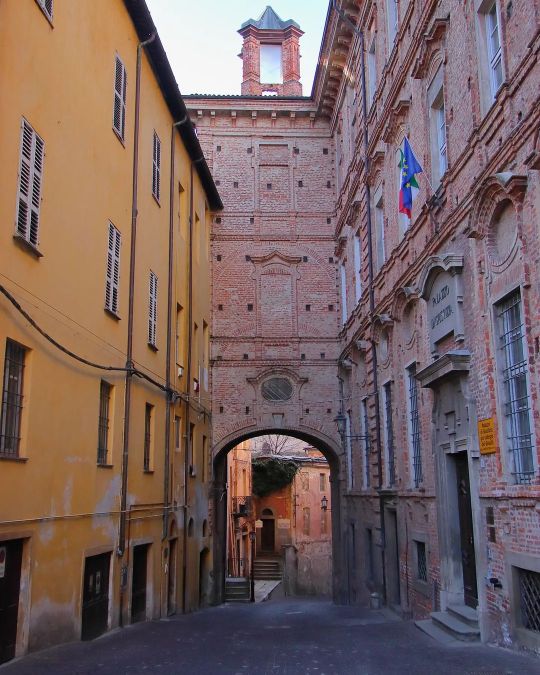
Canon EOS 250D | 20mm | 1/800s | f/3.5 | ISO 400 Taken on 15/02/2020. Scattered all over the huge Cuneo province, aptly called 'La Granda' (the Big One), are towns of historical and cultural heritage: Alba, Bra, Fossano, Savigliano, Saluzzo, Mondovì — the list goes on! To get an idea of Mondovì's medieval past, go up the funicular and have a wander round the historic centre, perched almost 400 metres above sea level. From the very top you are rewarded with a vast view of the snow-capped Alps, the Cuneo plain and the Alta Langa hilly area. 𝗛𝗼𝘄 𝘁𝗼 𝗴𝗲𝘁 𝘁𝗵𝗲𝗿𝗲: Take a Regional train from Turin, Cuneo or Savona. ______________________________________ #Mondovì #IgersCuneo #Ig_Cuneo #VolgoCuneo #Piedmont #Piemonte #StreetPhotography #OK_Streets #Italia #Italy #PiemonteConte #PiemonteTurismo #Visit_Piemonte #Piemonte_Illife #Piemonte_Inside_ #YallersPiemonte #Travelblogger #DiscoverItaly #ExploreItaly #ItalyTourism #Loves_MadeInItaly #TurismoPiemontese #Piemonte_In_Grande #VivoPiemonte #ItalyTrip #Travel_Europe #Italy_Hidden_Gems #ItalyInspired #ItalyMagazine #Living_Destinations (at Mondovì) https://www.instagram.com/p/CWk4CCloVAr/?utm_medium=tumblr
#mondovì#igerscuneo#ig_cuneo#volgocuneo#piedmont#piemonte#streetphotography#ok_streets#italia#italy#piemonteconte#piemonteturismo#visit_piemonte#piemonte_illife#piemonte_inside_#yallerspiemonte#travelblogger#discoveritaly#exploreitaly#italytourism#loves_madeinitaly#turismopiemontese#piemonte_in_grande#vivopiemonte#italytrip#travel_europe#italy_hidden_gems#italyinspired#italymagazine#living_destinations
0 notes
Text
professional help, c24. Christmas.

simon riley x original character.
trigger warnings: violence, sexual assault, mentions of rape, trauma, sexual themes, swearing, use of alcohol and drugs.
song to listen to when reading this: La sera dei miracoli, Lucio Dalla.
abstract: It's Christmas. it's Alba, I'm better now. I know you weren't expecting all that sweetness last chapter hu? brace yourselves, this one is even worse (literally nothing happens). anyway, I'm a fucking chef.
It was December 24th. She spent all day cooking and cleaning. It was surreal, she had come to life again to be the perfect housewife. She woke up at seven, took Jinx out, who was very happy to see her run with him and play fetch in the park. She cleaned her apartment, she did the laundry, swept the floors. She turned on the humidifier, put in lavender essential oil inside (yes, she really liked lavender). She proceeded to start cooking after lunch, she did dessert first. She made a simple chocolate cake that didn't require an extensive preparation and didn't need to rest. It was meant to have a fragrant external crust and be softer inside. She put on some music, she was singing along, she had her whole fridge restocked with fresh ingredients for Christmas dinner. She was a whole different person. It was probably too much food for two people. Two people as in her and Simon. He did, unbelievable I know, agree to Christmas dinner at her house in the end. 'Sure, okay', he had said, probably too embarrassed to say no in that moment. He had nowhere to go anyways… She asked him if he was allergic to anything, she was gonna make sure to add it to her shopping list. He said strawberries. She told him to bring wine, white wine. Goes with fish, cause yes, she was gonna cook fish. In Italy they don't eat meat the day before Christmas, a religious deal. She was going to have a fish based menu, it sounded fancy and she wanted to impress him. It was the first time she had ever had anyone over at her apartment. Salvo didn't count cause he was practically her brother and they usually had instant ramen together. She wanted to make a good impression, she hosted quite a few big dinners when she was in uni, hundreds with Salvo, and when she visited his family in San Francisco she always helped setting the table all pretty and cooking with his mom. She prepped two large cod fillets by marinating them with a few herbs and lemon. She checked on the cake, trying not to have Jinx jump inside the oven to eat it. She was almost anxious to have Simon over, not because of the fact he was who he was, but mainly for the cooking, and the menu and her apartment which was small and not too great…
He showed up exactly at eight, the time they had agreed upon. He had a bottle of wine in one hand, a box of chocolates in the other. Cause what the fuck are you supposed to bring for a Christmas dinner? Let alone, Christmas dinner at her house, them two together. He couldn't show up empty handed… Or maybe he could, he wasn't sure, he wasn't used to this. He debated on cancelling on her, he thought about it all week. He didn't have her phone number and he didn't want to ask Price, it would have sounded suspicious. He had to stop showing up at her workplace, so that was a no. Showing up at her house just to tell her that he wasn't going to that stupid Christmas dinner was gonna be even weirder. She had asked him in the worst timing possible, she had been crying and nearly got killed, he didn't feel like upsetting her further. And he had to come up with an excuse as well, one that wasn't that he hated Christmas for reasons he couldn't tell her. Last time he celebrated was so long ago he didn't even remember, he usually spent it at base, or drinking alone until he fell asleep. He sometimes went back to Manchester, though he stopped for a while. It was a time of sadness, a time of sorrow and deep anger. He didn't want to talk, he didn't want to eat, he wanted to be alone in his grief. He got the stupid chocolates cause he wanted to be polite, and he used to bring chocolates to his nephew back in the day when he went to see him… The only thing that kept him from cancelling was the fact that she was alone as well, for Christmas. He felt like he could endure an awkward dinner, so she wouldn't be alone. He felt out of place, he walked away from base like he was sneaking out. And he kinda hated himself for it, he was sure many men would have been be thrilled to be invited to dinner by someone like Alba. He didn't look the part. He wasn't made for that, and he wasn't going to change.
When she opened the door he knew he was doomed. The house smelled heavenly, there was music playing, the lamps were giving the living room a fait and tender orange aura. She was standing there, smiling. She had her hair up tied with a hair clip, she was wearing a black t-shirt and sweats. She was dressed to spend a night in, but still looked extremely put together. She looked gorgeous, that is. At her feet, Jinx was trying to get out the door and whining for attention. She said hi and let him step in. She was thanking him for the wine and telling him to put the jacket on the sofa. When he noticed the table he understood how much of a mistake going there was. She was fucking too much, she was unbelievable. What the actual fuck did I get myself into…
There were two tablecloths on the kitchen isle, a cotton one and a paper one, the ones you can throw away after use. She had drawn on the white paper with a black sharpie. She had drawn two plate shapes, two round shapes where the wine glasses stood and wrote 'Simon' on the side. He stood petrified looking at his name in that beautiful cursive handwriting, the letters majestically floating just above the plate shape. 'Alba' was written in the same handwriting on the other side of the isle. Simon and Alba. He didn't belong there… 'I saw it on Instagram', she said, circling him and getting to the fridge. 'The drawings', she added once she noticed he was still standing in the middle of the living room. He managed to swallow the lump in his throat and put down the wine and chocolate. 'Oh, thanks, these look nice.' She took the box and inspected the flavours list. She would tell him later that dessert was covered… She gave him a bottle opener while she got the appetisers from the fridge. 'So this is hummus I made, and this is a ricotta cheese spread with basil and honey', she set two plates on the counter in front of him. She had two types of tortilla chips in a little bowl, and in another plate, cucumber and carrots to dip in the whatever she had made. She set everything in front of him and finally stopped to properly look at him for a second. He looked incredibly lost. He looked small, he clearly was out of his comfort zone. He looked out of place, behind him was her small home library and her paintings on the wall, he looked like a fish out of water. She let her sight linger on the features that weren't covered by the black mask. His messy hair, his forehead, his cheekbones. His nose looked more crooked than usual, his eyes a mixture of frightened and surprised. For a second she thought the drawing was too much, or maybe the food was too fancy for him. She quickly changed her mind, the hummus was fucking amazing and homemade, what more did he want uh? Plus, she had pasta and fish to serve, it's not like he would starve…
'Sit down.' It was an order, but her voice was too soft to sound intimidating. Jinx had immediately started bothering him, trying to get him to give him some food. 'You can take off your mask, I'll turn around.' He looked at her turn to the stove, getting a pan and removing something from it, then he heard the sizzling of onion or garlic or something like that? She was moving like a professional, chopping stuff and stirring what looked like spaghetti… He didn't know how to feel, it was like he stepped into another reality. The smell of fish and rosemary, the faint music, her. She had turned around so he could eat. It was considerate of her, no? He tried the hummus, which was very nice and spicy. The other dip was fresh and aromatic, a good balance of sweet and sour, he was impressed. 'You're not gonna eat?' She didn't turn around. 'Yeah later, this is just appetisers.' He nodded even though she couldn't see him. She took the lead of the conversation. 'What wine did you get?' He quickly grabbed the bottle and started opening it, so he could keep himself busy. 'Hum… chardonnay?' he said. 'Good choice.' He wanted to tell her it was probably a cheap bottle. He realised he should have gotten a better one. He should have gotten more chocolates and maybe something else, he wasn't at her level. She strained the pasta. He asked her if Jinx could have a chip, she said only a small piece. 'Can I turn around?'
Now, he really didn't expect she would ask. He didn't really eat around people, when he drank in public settings like a pub, he kept his mask on his nose or made sure to have it on most of the time. She already saw half of his face when they ate that burger together. He thought about it for what felt like hours, deep down he wanted to be normal, he wanted to feel at ease and just relax for a second, she had even asked him permission... He put his mask back on and told her to turn around. When she did, she placed a pan on the table. 'Calabrese', she said. 'It's from a region in the south of Italy, I had a roommate that was from there.' She served him a good portion of spaghetti, topping them with the sauce that was at the bottom of the pan. 'Melted anchovies, chilli pepper, tomatoes…', she grabbed a small bowl, '…toasted breadcrumbs and basil, which are optional but recommended.' She raised her eyes to look at him, in sitting quietly on the small stool with is shoulders curved foreword. 'I can go eat on the sofa if you want, it's not a problem.' She wanted him to trust her really bad. The fact that he had that fame of unbreakable soldier with a hard past intrigued her, she wanted to know him and she felt like she had the power to do so. She was polite, she was respectful of his boundaries, she was understanding and would not push him. She wanted him to feel alright in her presence.
He felt that from the way she was talking to him. He felt dizzy and uncomfortable, she was putting him in a position of complete control over the situation, she was giving him a choice and offering to keep his face concealed, his identity protected. Protected from what, he wasn't at war, fucking hell. He was with the girl he had thought about at night, truth be told. He was with Alba who he had talked to before, in situations in which he went to see her because he craved her presence. He was with her right that second. She had cooked all that just for him, she let him into her house, him specifically and only him, her fucking dog was licking his shoe right that second.
'No you can stay', he slowly peeled off his mask and put it aside.
'There's your name written on the table.'
notes: nice… pasta recipe soon?? also December 24 and it's chapter 24, guys I'm a witch.
notes: i hope you liked the' first hug' moment in the last chapter and this kinda first moment alone together. a reminder, these two have a enemies to colleagues to major enemies to lovers kinda trope sooooo... I don't know, we'll see what happens I guess, I have a few more chapters written down and then it's season two. we'll just have to wait and see eheheheh. love y'all.
taglist:
@ghostlythots @sweetfemmefatal @natxpat @chavarriakeren647 @ravenmoore14 @farther-than-pleiades @internallyscreamings @hwromi @atoxicrat @cuti3maddi3 @deafeningkittenblaze @its-celeste @serene-hills @lexidoll12 @poohkie90 @lunatiquess
@warmedbythebody @katzykat @iristhemuse @azkza @keiraslayz @abbyandermine @jennyjencakes @dest-nai @corset-briefs @nutze-kekse @ilytsukiw @b3anspr0ut
@pondsblog @missyouzoe @fallenkitten @bigauthorrascalturkey @bethtay @angelynn-nicole @starluv @stargirlisworld @giyuuslittleslut @impossiblecupcakelight
@rkrivees-blog @ghosts-hoe @kam1snotverysmart @gauky76 @freyjaaasstuff @spicyspicyliving @scottpilgrimvsmyfists @courtney0-0 @shinchanboi @darling006 @my-therapist-hates-me
#ghost cod#simon ghost riley#cod mw2#ghost fanfiction#call of duty#cod fic#cod modern warfare#cod 141#task force 141#ghost mw2#mw2 ghost#ghost simon riley#simon riley call of duty#simon riley#taskforce 141#tf 141#cod#soap cod#cod mw3#cod mwii#modern warfare#modern warefare ii#call of duty modern warfare#gaz call of duty#call of duty mw3#ghost call of duty#simon riley fanfic
14 notes
·
View notes
Text
Italian Food and Wine Pairing
https://j.mp/3ke1eqz Italian food is beloved everywhere. Because of that, you will see sommeliers pairing Italian dishes with wine from nearly every country in the world. A good Chilean Sauvignon Blanc will match beautifully with minestrone, and an Oregon Pinot Noir tastes amazing with agnolotti. The modern sommelier sources the best wines for each dish, whether they come from the same place. Table of contentsEvery Italian Region is UniquePiedmontLiguriaEmilia RomagnaTuscanyAbruzzoRomeCampaniaSicilyUntil Next Time Every Italian Region is Unique Having said that, local pairings often tap into a deep culinary tradition. It’s not a cliché to pair Italian wine with Italian food –or that what grows together goes together– both evolved together to merge seamlessly on the table. However, keep in mind that Italian cuisine is very regional: your wine pairing should be, too. There is no one type of Italian food but many. Every region in Italy was brought together for historical, political, and economic reasons. Each one has unique local gastronomic traditions, ingredients, and specialties. The following are just a few regional pairings for Italian food and wine. If you are interested in learning more –and happen to live near Philly– you should attend one of our food and wine pairing classes. Piedmont Northern Italy is home to Piedmont. Butter reigns and not olive oil. Starchy polenta and risottos are more common than pasta. Hearty dishes of beef and game are ubiquitous and often overpowering. Menus are dominated by earthy, rich dishes that are both rustic and refined. And they don’t skimp on the local white truffle when it’s in season. Alba Truffles are the region’s most cherished ingredient. Piedmont is renowned for its wines, especially the age-worthy Barolo and Barbaresco made from Nebbiolo grapes. Other grapes, like Barbera and Dolcetto, also make good but least expensive bottles. A classic food and wine pairing is Brassato al Barolo and a Langhe Nebbiolo. Slow-cooked in wine, Brassato al Barolo is tender and very beefy. The dusty tannins of the Nebbiolo hold their ground against this robust dish. The dish should be served with vegetables and polenta. Liguria South of Piedmont, with incredible sights of the Mediterranean, is Liguria. A small, steep piece of land home to some of the most underrated Italian white wines. Pigato, known elsewhere as Vermentino, is a noble grape that produces fresh, crisp, fragrant white wines that go well with seafood and light dishes. In Liguria, Pigato is splendid with one of the region’s specialties: Pesto. A favorite pairing is Trenette al Pesto and the white wine Colli de Luni Vermentino: A linguini-like, long noodle is tossed with pesto Alla Genovese. Add a sip of the grippy Vermentino, and you have pure heaven. Emilia Romagna Emilia Romagna is the heart of Italian cuisine. The collection of premium products of the region is stunning. Modena’s balsamic vinegar, prosciutto di Parma, Parmigiano Reggiano, what else do you need? Winemakers make both the cheap, sweet fizz you love or hate and higher quality, dry reds with an enviable palate. A classic pairing is Prosciutto di Parma and Lambrusco secco. A dry Lambrusco from a quality producer is insanely delicious with ham and cured meats. The soft palate compliments the salty, meaty, strong flavors in prosciutto. Vast vineyards planted with Lambrusco seem infinite. Tuscany The classic food and wine pairing in Tuscany are Bistecca Fiorentina and Sangiovese. Tuscany is identified for its rustic red wine and its amazing rolling hills dotted with pine trees. The cuisine is modest and intimate except for the over-the-top Bistecca Fiorentina, a large T-bone steak that needs a robust wine by its side. Pair this beef steak with an age-worthy Brunello di Montalcino, Vino Nobile, or Chianti Classico Reserva, and you will be in heaven. v Abruzzo Abruzzo is a quiet region isolated by mountains. Its cuisine is divided, with seafood at the shores and meat on the hills. Seafood dishes pair well with uncomplicated Trebbiano d’Abruzzo wine. Tomato-based pasta like spaghetti alla chitarra is excellent with the reds of the region. The classic pairing is Arrosticini and Montepulciano d’Abruzzo, a wine that is slowly becoming fashionable amongst sommeliers. Arrosticini is traditional lamb skewers that are best enjoyed with a medium-bodied Montepulciano d’Abruzzo. The intense, juicy lamb skewers are lifted into elegance with the round, balanced fruit and coating tannins of the wine. Rome Italy’s capital is Rome, and Rome is all about eating. With an extensive gastronomic offer, the iconic Roman dish is spaghetti alla carbonara. Egg, cheese, pepper, and guanciale (cured pork cheeks) make the base of this creamy pasta dish. Like dry Frascati, a fresh white wine of the locality, made with Trebbiano and Malvasia, tastes fantastic with the recipe. The crisp acidity cuts through the fat and cleanses the palate. Classic Pairing: Carciofi alla Romagna and Frascati When in Rome… Campania Italy is mostly surrounded by water, which means seafood abounds. The Campania region, especially the capital city, Napoli, has some of the finest seafood in the world. Of course, Napoli is mostly remembered for its pizza, which is locally paired with beer. Yes, what is thought to be a classic Italian food and wine pairing (pizza and red wine) is an American invention. In Campania, a classic pairing is Risotto alla Pescatora and Falanghina. Creamy risotto with mixed seafood shines when combined with a light-bodied, high-acid white wine like Falanghina. You can pair any of the local seafood with one of the many dry white wines made here. The most important grapes are Greco, Falanghina, and Fiano. Sicily Last but not least comes dessert. Sicily has a varied cuisine crowned by its pastries and sweets. You can find cannoli, a sweet tube-shaped pastry filled with sweet ricotta cheese, everywhere, but the best is enjoyed at the source. The classic Sicilian pairing is Cannoli and Marsala. A cannolo filled with sweet ricotta pairs well with a delightful, fortified sweet Marsala. For an appetizer, nothing is better than a Sicilian Arancini with a glass of Nero d’Avola. Until Next Time We can go on and on. Italian food and wine pairing is a subject that takes a lifetime to master. Just remember that local food goes well with local wine, especially when you talk about Italy. A little research will help you find adequate regional pairings that will work every time. Tasting & Pairing Classes Wine Tasting Cheese Pairing Cocktails Food Pairing Wine Pairing Articles Food and Wine Pairings German Food and Wine Pairings Italian Food and Wine Pairing Worst Food and Wine Pairings Wine and Cheese Pairing Bad CHeese Advice from a Sommelier By Keith Wallace https://j.mp/3ke1eqz
0 notes
Text
Wine 101: Barolo and Barbaresco

This Episode of Wine 101 is sponsored by LUX Wines. LUX Wines is an importer of luxury wines from prestigious wineries around the world. Carefully curated, the Lux Wines collection showcases an evolving selection of the finest wines from some of the most revered winemaking families. We are the storytellers and stewards of their family legacies, and we can’t wait to share it all with you. Discover our exceptional wines and esteemed winemaking families at luxwines.com.
In this episode of “Wine 101,” VinePair tastings director Keith Beavers explores Barolo and Barbaresco. He begins the episode by warning fans that these styles encompass some of his favorite wines in the galaxy, but after listening to his explanation of the work that goes into these wines, Barolo and Barbaresco essentially speak for themselves.
Both styles are made from the Nebbiolo grape in Italy, though different areas produce wildly different wines based on factors like soil type, aging requirements, and winemaker style. Beavers explains that the focused Barolos available today took years to perfect, with experimentation beginning in the mid-19th century. Wine regions evolved through the sudden convergence of wealth, power, and winemaker knowledge and eventually gave way to intense, structured wines.
Back then, Nebbiolo was often grown only to be included in Barolo blends. It was not until 1894, when a co-op then named Cantina Cooperativa di Barbaresco began producing Barbaresco to be consumed on its own, that Barbaresco really made a name for itself. Today, consumers can still find affordable wines from this co-op, though Beavers warns that Barolo and Barbaresco can also be some of the most expensive wines on the market. That said, he insists they are well worth the price and can “probably change your life.”
Listen online
Listen on Apple Podcasts
Listen on Spotify
Or Check Out the Conversation Here
My name is Keith Beavers, and Disney just announced 10 new “Star Wars” projects and a new era of “Star Wars” showing up in novel form on Jan. 5, which is my birthday. I’m so excited, oh my God!
What’s going on, wine lovers? Welcome to Episode 30 of VinePair’s “Wine 101 Podcast.” My name is Keith Beavers. I am the tastings director of VinePair, and what is going on? I can’t express how excited I am to talk about what we’re about to talk about. Have you ever heard of Barolo? You’ve heard of Barbaresco. It’s red, it’s expensive, it’s from Italy. Let’s drill down on this, ‘cause you’re going to love stuff.
OK, wine lovers. This is a full-disclosure here before we get started. The wines we’re about to talk about today are my favorite wines in the galaxy. I would fight VinePair CEO of Adam Teeter for these wines. Maybe we have fought over these wines before. They are my favorite. So I’m going to be very excited. I love this stuff. I owned an Italian restaurant for 10 years, and Italian wine is some of my favorite wine in the world.
Let’s just get into this. In the northwestern part of Italy, there is a region called Piedmont. In Italian, it’s Piemonte, which means the foot of the mountain or the feet of the mountain because of its proximity to the Alps. In the southern part of Piedmont or Piemonte, there is a grouping of hills, just absolutely visually stunning hills.
And this is called the Langhe. In the old dialect of this region, the word langhe means low-lying hill. So this grouping of hills is the plural of that called the Langhe. Sometimes in English, we call it the Langhe hills, which is a little bit redundant, but whatever. It’s hard to describe how beautiful this place is when you’re looking at this, just Google it. It’s absolutely amazing. It’s actually a UNESCO World Heritage Site. It’s just stunning.
And in these hills is a very famous town called Alba. It’s a center town where people would gather from around the area. About nine miles southwest to the town of Alba is another town called Barolo, and the vineyards surrounding the town of Barolo and other townships consist of one grape, a red wine grape called Nebbiolo.
It is one of the most revered varieties in this region. It’s one of the most revered varieties in Italy, and the wine that is made from the Nebbiolo grape in this area is named after that town Barolo. About 15 miles northeast of Alba is a town called Barbaresco, and in the vineyards surrounding Barbaresco and a couple of townships is one grape. And that grape is also Nebbiolo. And the wine made here from the Nebbiolo grape is named after the town Barbaresco. The wines made from the Nebbiolo grape in these two towns are some of the most age-worthy wines in the world, some of the most expressive wines in the world, some of the most dramatic red wines in the world. But it wasn’t always that way.
We have to go back to Barolo, and we have to go back to about the mid-19th century before the unification of Italy. What’s interesting about this area is in Europe and especially Italy, there’s so much ancient winemaking going on. And then these regions evolve through this particular tradition. This area wasn’t like that. Wine in Barolo and the surrounding area before the 19th century was just sweet fizzy red wine. It was a bit unbalanced. But in the mid-19th century, there was a convergence of wealth, power, and wine knowledge that came together to create what we know today. It’s pretty awesome.
Camillo Benso, Count of Cavour, lived in Barolo on his Grinzane estate. He was a statesman. This area of Italy is very Francophile, and his mother was French. His father was Italian. Actually, his godmother was the sister of Napoleon. So this guy had money. He had power. He actually eventually became part of the movement towards Italian unification. He had a newspaper called Il Risorgimento. He would eventually become the prime minister of Italy and Sardinia — that’s a whole story — and then just the prime minister of Italy. So this guy had some power. He was also very well traveled, and he would go to France a lot and just learn about how they made wine there. And he would come back to his estate, which obviously had vineyards on it ’cause he’s Italian, and he saw an opportunity to change the way wine was made in his region.
He had a man under his employ, a retired general by the name of Paolo Francesco Staglieno. And this guy was a studied enologist as well. And in the research, this is where things get a little bit fuzzy, but what it feels is that Benso and Staglieno used knowledge they gained in France to reform and change the way wine was made in Barolo.
It was a lot of stuff. They changed the way wine was fermented. They changed the way the wine was aged. They changed the way the wine was grown. Where at one time it was all just field blends like it was back in the day in Bordeaux, they decided to do monoculture vineyards, meaning just one variety per vineyard.
And with these techniques, they basically changed the way wine was made in Barolo. And this is really the moment where we start seeing the Barolo that we know today. So the thing is, I believe the quality of wine was improving in this area. And just north of the town of Barolo is a town called La Morra — a commune I should say.
And in that commune, there was a big estate from Giulietta Filetti. She was the marquee of Barolo. She gets wind of this quality wine, and she starts doing the same thing they’re doing on her estate in La Morra, which is a town about a little bit north of Barolo. So now it’s starting to spread.
And then, King Carlos Alberto of Sardinia has a resort in this area. He gets wind of it. He starts making wine in his estate, and then another count, Count Emmanuel Fiore, develops vineyards around his hunting lodge in that area called Fontana Alfredo, which is actually still there today.
And with this new style of wine gaining in popularity, down in the Goria — which is the region just south of Piedmont and Genoa, which is now Genova — there is a wine merchant by the name of Louis Oudart. Now, usually often he’s thought to be the guy that actually went and did all the consulting with everybody. But recently it’s shown that he actually didn’t. He had a house, he was a merchant, and he had a maison in Genoa because Genoa had a really thriving French community. And he would spend a lot of time in Barolo and Barbaresco and bring wine back and bottle it and sell it through his house, through his maison.
And I think that’s where everything started becoming popular outside of this area. So all this stuff was happening at once. And then at some point, Barolo becomes known as the Wine of Kings and the King of Wines. And all of this development of land and winemaking practices is what we have today in the Barolo region.
Barolo is such a fascinating wine. It’s elegant. It’s powerful. It’s tannic. It’s expressive aromatically, but it has just bracing acidity that will not allow the wine to overwhelm your palate. It’s incredible. And what’s really wild about Barolo and wines made from Nebbiolo, in general, is the alcohol is often 14 or 14.5, and that’s high.
And you would think when you had a wine like that in your nose, you would smell and feel the alcohol. But no, you don’t. Barolos are so balanced that you don’t even know what kind of alcohol is in it. You only know that it’s 14.5 percent because you look at the label. It’s just the most fascinating stuff.
And these wines can age for so long, and they actually have to age in barrel and in bottle for a long time before it actually gets to the market. It has to age 38 months, and at least 18 of those months need to be in the oak. And for the riserva, it’s 62 months, with at least 18 months in the oak.
And the color of this wine is just such a joy to look at. It’s almost like the color of a Pinot Noir, but it’s more ruby because it has this wild brickish, rusty tinge to it. Wines that usually have that are wines that have aged for a while, but this wine has it in its youth. And speaking of youth, it’s all cherries and plums, but as it starts to age, you get dried cherries and rose petals and tar and tobacco and licorice.
But all of that is very, very, very balanced. And it depends on where in Barolo the wine is made that gives you all the different variations of what I just spoke of, because Barolo is made up of five townships. You have the town and surrounding area of Barolo. Then you have just north of that the commune of La Morra, where Giulietta was doing her thing with her estate. East of Barolo, you have a commune called Castiglione Falletto. South of that commune is Serralunga d’Alba. And south of that commune is a commune called Monforte d’Alba. And the reason I mentioned these five townships is because the soil compositions are unique so that the expression of the Barolo is different depending on what township the wine comes from.
You’re not always going to see that in big letters on the label. You’re going to see Barolo, and it’s going to say who made it, and somewhere on the label, it’s going to say one of those townships. Or if the wine comes from a single vineyard, the name of that single vineyard will also be on the label.
And it’s a little bit weird because these townships aren’t front and center on the labels, but they’re important. Because wines coming from Barolo and La Morra, which is Barolo, then just north of that is La Morra. This area is a more fertile soil. And even though Barolo is always going to be powerful from these two townships, you’re going to get a little bit more aromatics. It’s gonna be juicier and fruitier. The wines are gonna feel a little more broad in the palate, and they actually age a little bit faster. So it’s one of those wines you can drink earlier than you would from other areas in Barolo. Going east from Barolo, you go down into a valley then back up into some hills.
And those hills are much less fertile than the soils over in La Morra and Barolo, and you have the Serralunga d’Alba, and then south of that you have Monforte d’Alba. The Barolos that come out of these two townships are very big, they’re structured, they take longer to age, and they’re not approachable as soon as you would want. They have little more oomph to them. They’re a little more intense, I guess.
And then the last township, Castiglione Falletto, is this very unique place, because it’s at a higher elevation. It’s on the spur of these hills. And because of the less fertile soil, it’s still very intense, but because of the sun exposure, it creates more fruity flavors.
So it’s the best of both worlds. You get a little bit of the Serralunga d’Alba, Monforte d’Alba, a little bit of La Morra Barolo in the Castiglione Falletto. I’m hoping you guys aren’t confused. This is a lot, but it’s pretty awesome stuff.
So to sum up, Barolo is made up of five townships. Each township has very unique soils. In two townships, you get fruitier Barolos. In three townships, you get more intense Barolos, and then one of those townships has more fruit than the other townships. The thing is, you’re just going to drink Barolo, and when you buy a Barolo, take a look at where it’s from, and then use that stuff.
Maybe don’t think, OK, I’m going to go get a Monforte d’Alba because of the pizza. Just go and buy Barolo and drink it, and then look on the label, see where it’s from and go, “Oh.” Take a note in your head, write a note on a piece of paper, go buy another Barolo from a different township, take notes on that. That’s just that’s really how to do it.
So like I said, Barolos are always powerful. Wines made from Nebbiolo are always powerful. It’s the nuances that change and define wines made from this grape. And earlier, we were talking about a town 15 miles northeast of Alba called Barbaresco.
And the reason why I didn’t talk about that in the beginning is because in Barolo, there’s the history in Barolo. For a long time, the wine and grapes in Barbaresco were used to blend with Barolo. This was back in the day, and it wasn’t until 1894 that the word Barbaresco started showing up on wine labels.
And that’s because a guy named Domizio Cavazza, who was an enological professor at the school of Alba, he founded a big co-op in Barbaresco. It’s called Cantina Cooperativa di Barbaresco. It was a different name then, that’s the name of it now, but it’s still around. It is a really good source of very awesome affordable Barbaresco on the American market. It’s easy to find, it’s awesome stuff.
And from 1894 into the 1960s, that was the thing that was going on. And then it wasn’t until the 1960s that we had winemakers who started doing the things like Barolo did back in the day in Barbaresco to focus this place. Giovanni Gaja, Bruno Giacosa, and Alberto di Gresy: These three winemakers, with their individual companies, redefined what Barbaresco was into what it is today. And you can find these wines on the market. They’re all over the place, they’re very expensive these days, but they’re absolutely stunning wines, and they started basically everything.
And Barbaresco is a small place. It’s a third of the size of Barolo. They have townships as well. But there’s not as many. There’s only four. There’s Barbaresco, there’s Treiso, there’s a commune called Neive, and then a little slice of Alba.
But the thing is, the wines made from Nebbiolo here, ‘cause they’re all made from Nebbiolo, they’re different. Because there’s a unique type of soil here that is a fossil-based soil, but they’re also very close to the Tanaro River. That actually helps moderate temperatures and how these vines mature through the growing season.
And the result of those conditions is a powerful wine. Nebbiolo is always powerful, but here, there’s a little more leanness to it. Just a little more elegance. There’s such a “lift” on the palate of Barbaresco, and it still has the intensity of tannin — actually more so because of that soil — and it still has that vibrant acidity and it still has that dramatic fruit.
But the expression is just a little bit different. You can actually sense all three of them on the palate where Barolo, it all comes together in a blend, which is beautiful. But there’s something separate about Barbaresco. There’s the tannin, there’s the acidity, and there is that beautiful perfumed fruit.
It’s a little bit more perfumed than you get from Barolo.You get violets, you get bright cherries, and when it ages, that tar is still there, that tobacco, but you get this undeniable note of orange peel, and it’s just very refreshing, very beautiful.
And you can tell in the aging requirements, Barbaresco is released earlier. It’s only 26 months required to age with nine months in oak, as opposed to the 38 and 18 month for Barolo. And for riserva, it’s 50 months instead of the 62 months for Barolo. So you get a sense of it’s a little lighter, more elegant wine.
None of these wines are better than the other wines. They’re all phenomenal, amazing wines. It’s just that these two towns, and the wines made in these two towns, are these beautiful, intense, structured, phenomenal wines that age for a very long time. And all you have to do is explore them. And every township has a uniqueness to it, but every township is awesome.
So I hope you guys are getting a little bit of a sense of the wines from these two regions, I am head over heels for these wines — they’re the best in the galaxy as far as I’m concerned. So I’m waxing on and off here and getting very passionate about it. I’m hoping I’m not too crazy, but I just want to convey to you the wondrousness of these wines.
And these wines can be expensive. They start around $30, $40 at the way-low end, but $50, $60, $70, that’s how much these wines are going to be. But there’s a reason for that. Barolo is one of the most intelligent, focused wine regions in Italy, if not the world. And it is just a very confident place with very good, focused wine, and the yields are very focused as well.
So you’re paying for something that is going to probably change your life. Well, it changed mine.
If you’re digging what I’m doing, picking up what I’m putting down, go ahead and give me a rating on iTunes or tell your friends to subscribe. You can subscribe. If you like to type, go ahead and send a review or something like that, but let’s get this wine podcast out so that everybody can learn about wine.
Check me out on Instagram. It’s @vinepairkeith. I do all my stuff in stories. And also, you got to follow VinePair on Instagram, which is @vinepair. And don’t forget to listen to the VinePair Podcast, which is hosted by Adam and Zach. It’s a great deep dive into drinks culture every week.
Now, for some credits. How about that? Wine 101 is recorded and produced by yours truly, Keith Beavers, at the VinePair headquarters in New York City. I want to give a big shout-out to co-founders Adam Teeter and Josh Malin. I also want to thank Danielle Grinberg for making the most legit Wine 101 logo. And I got to thank Darby Cicci for making this amazing song: Listen to this epic stuff. And finally, I want to thank the VinePair staff for helping me learn more every day. Thanks for listening. I’ll see you next week.
Ed. note: This episode has been edited for length and clarity.
The article Wine 101: Barolo and Barbaresco appeared first on VinePair.
Via https://vinepair.com/articles/wine-101-barolo-and-barbaresco/
source https://vinology1.weebly.com/blog/wine-101-barolo-and-barbaresco
0 notes
Text
besties, i'm going to be inactive for a week!!
i'll be in italy (6-11) and surely won't have time to be tumblring. tag me in whatever you want me to see when i come back and feel free to drop an ask if something important happens.
thank you !!

#alba rambles#alba goes to italy#ethan torchio if you're seeing this hit me up#my destinations are bologna firenze and siena#but i can change my plans for you anytime
21 notes
·
View notes